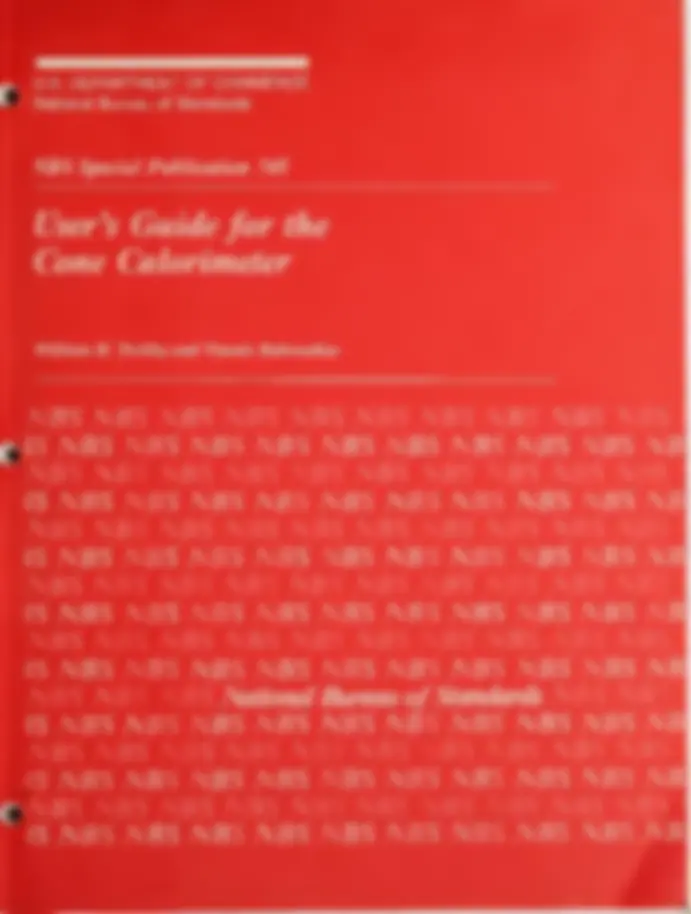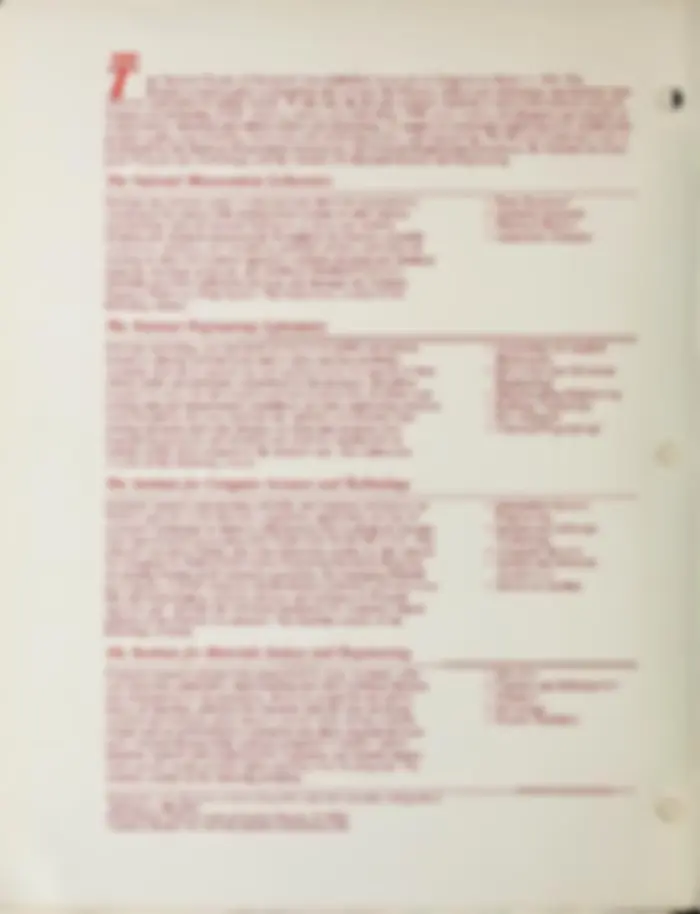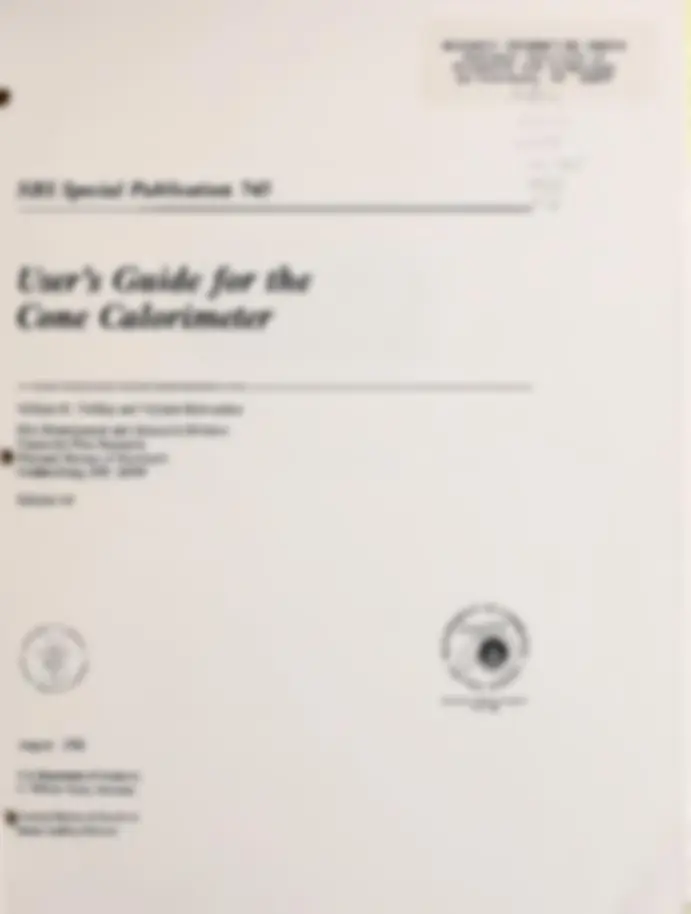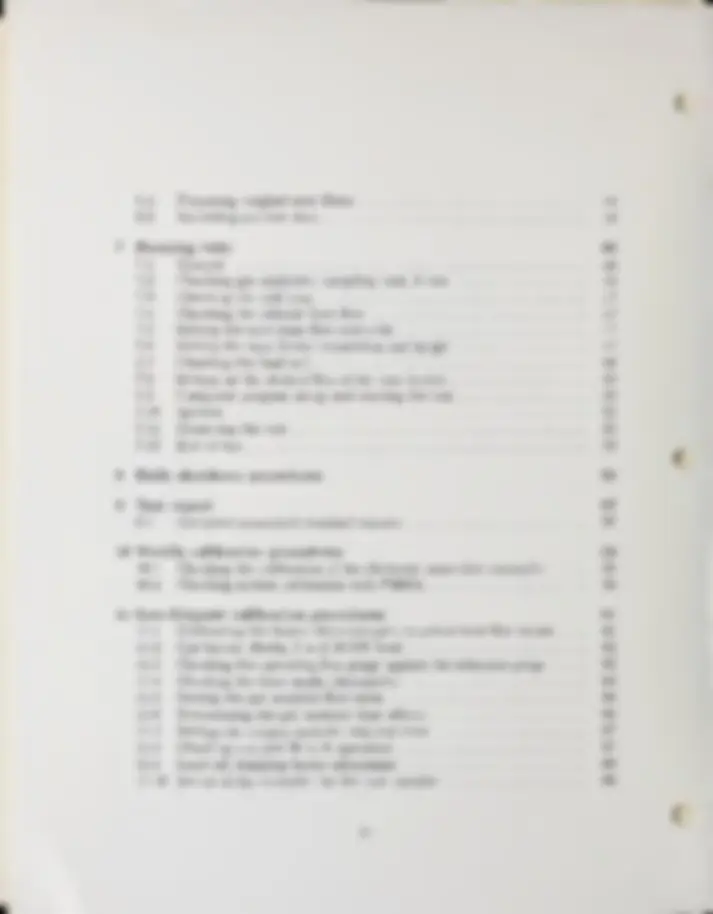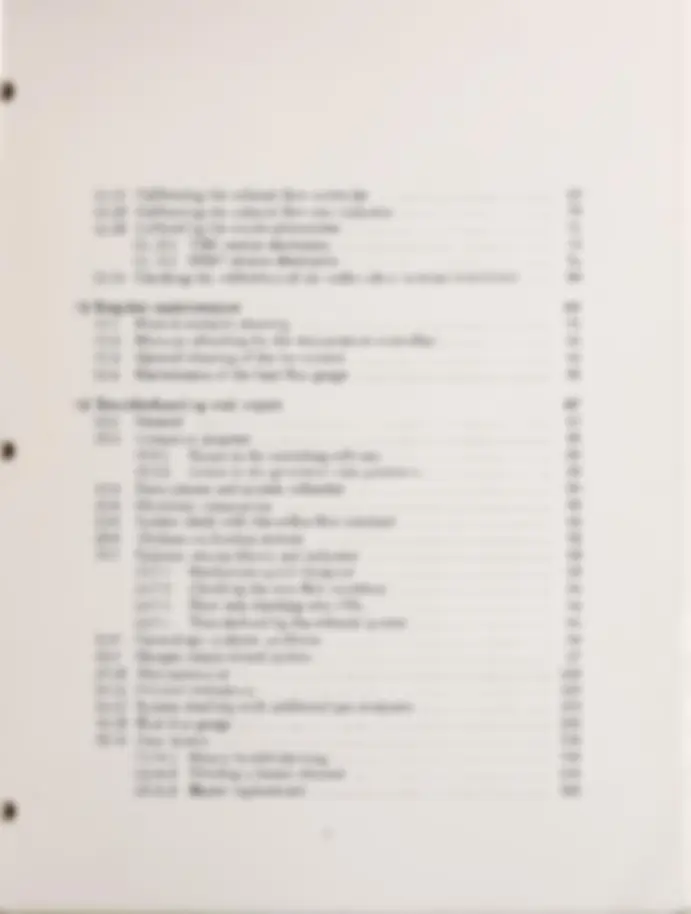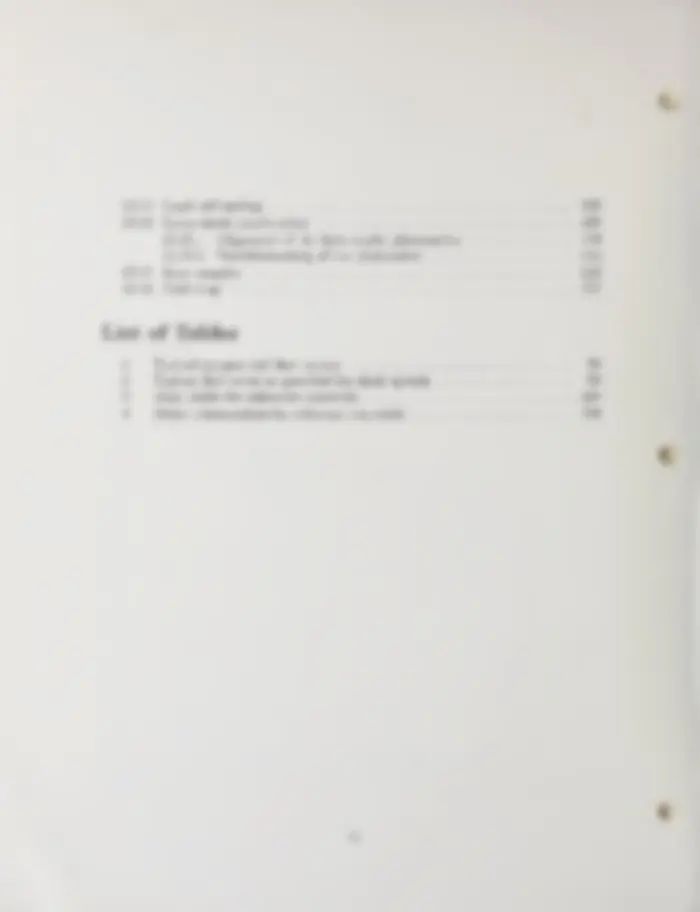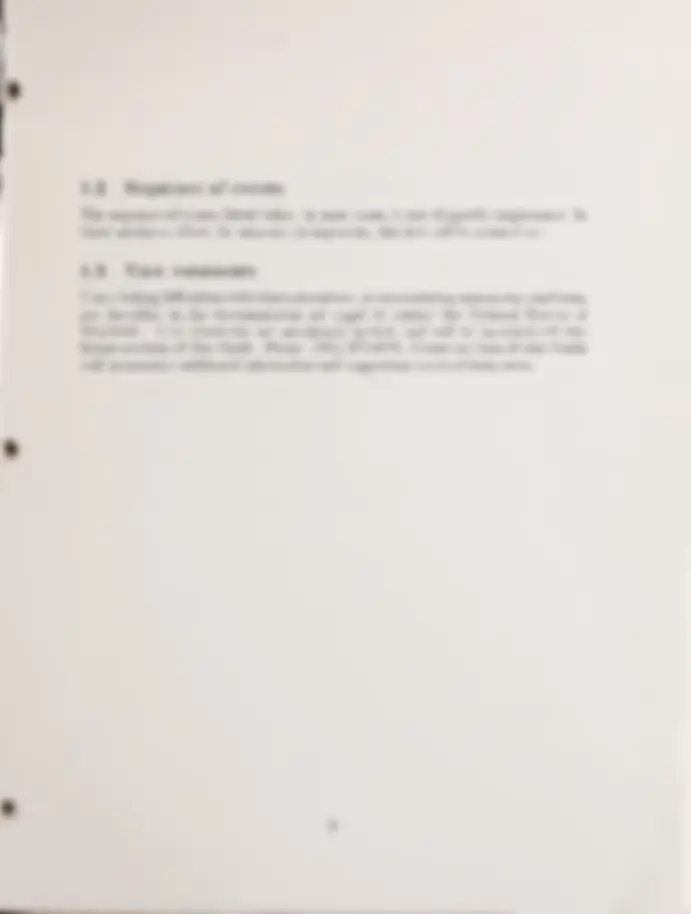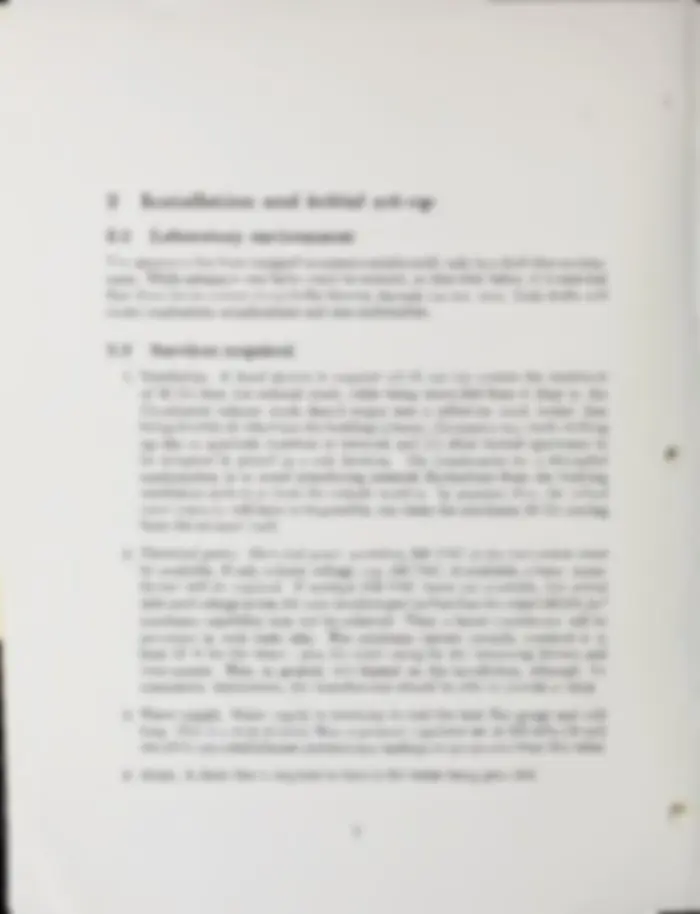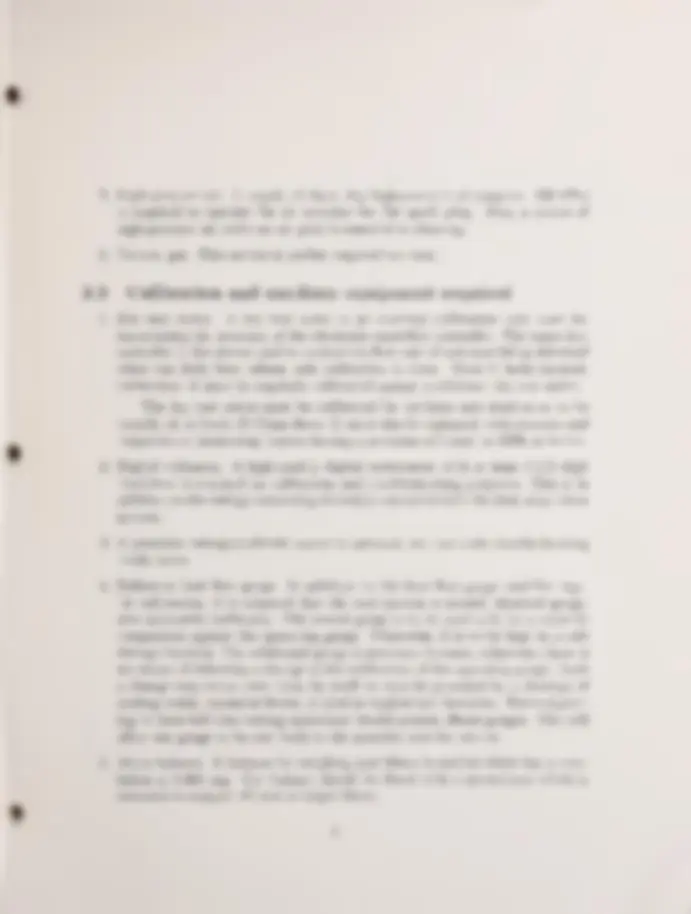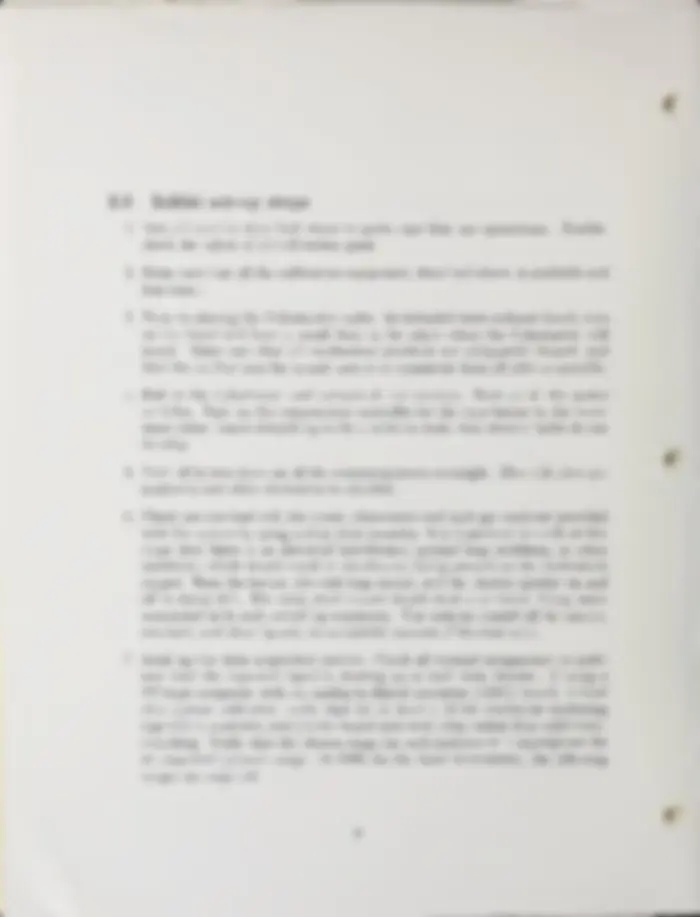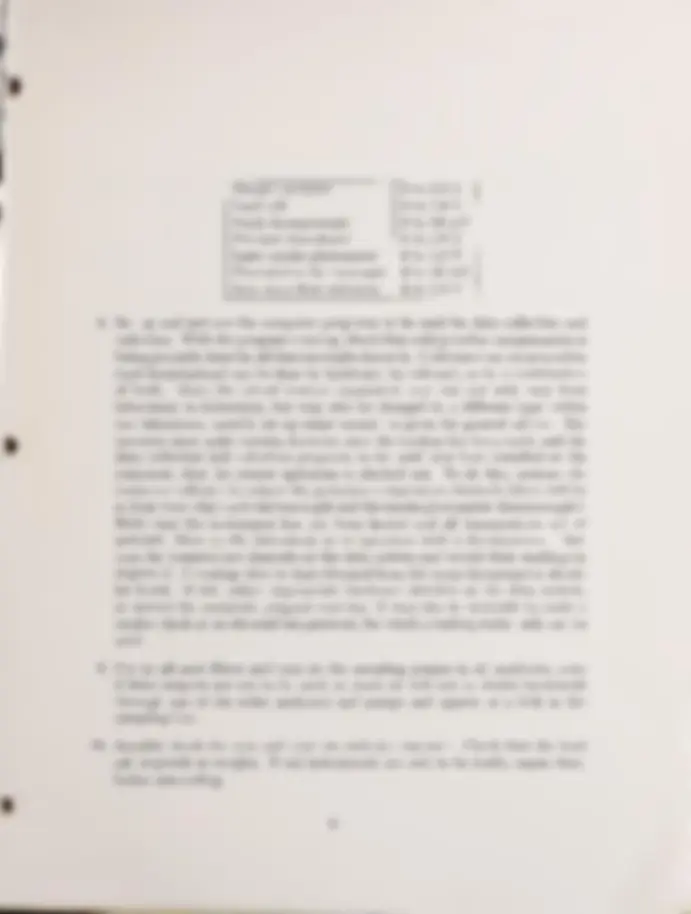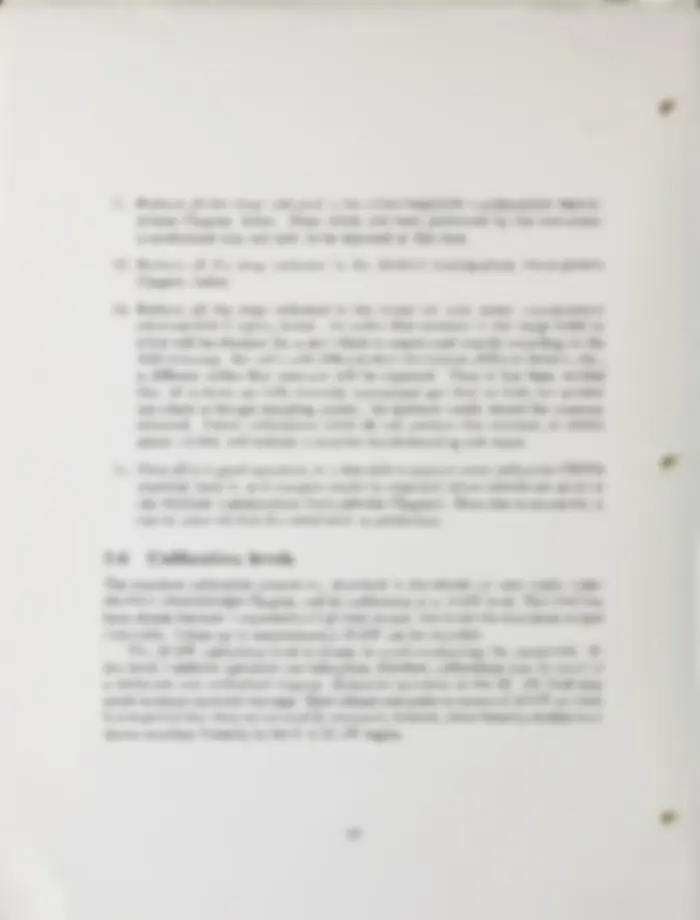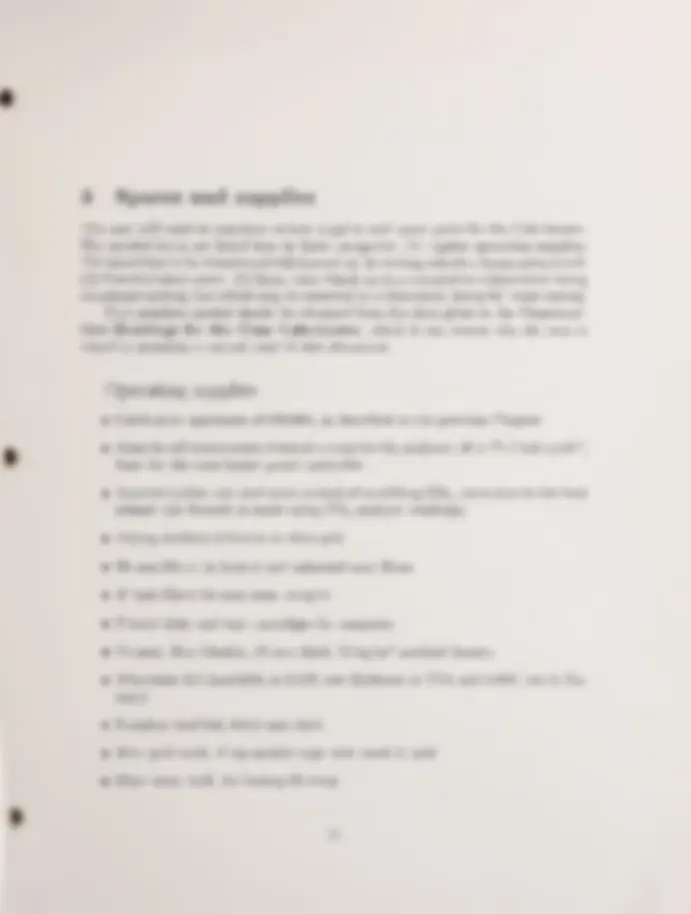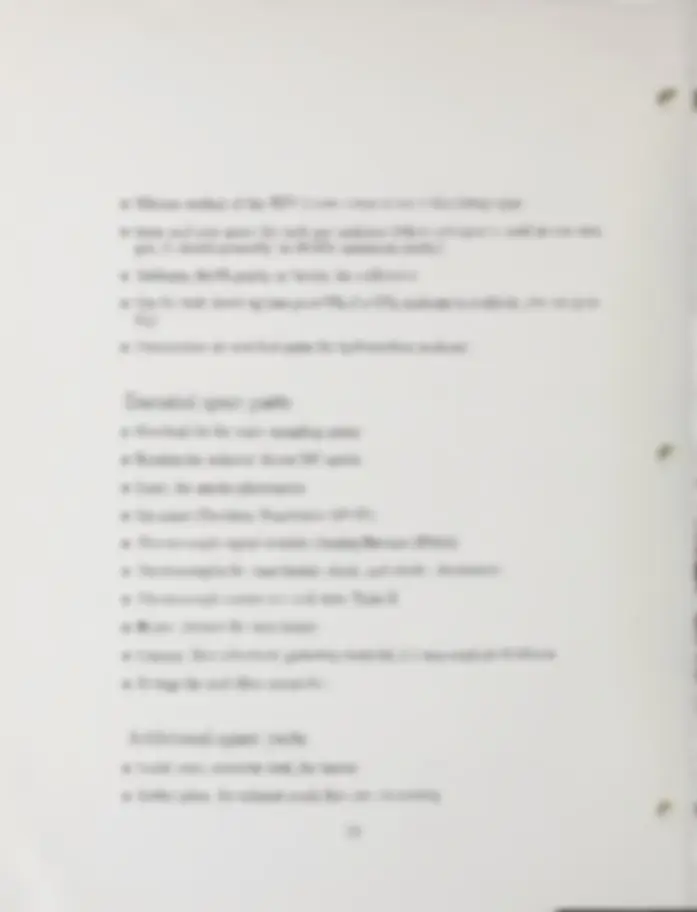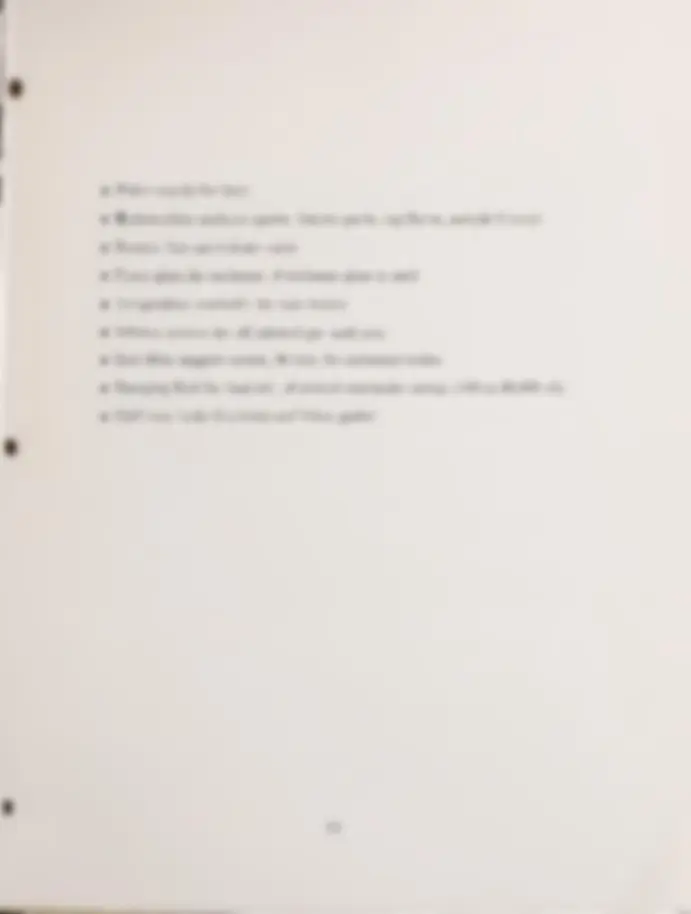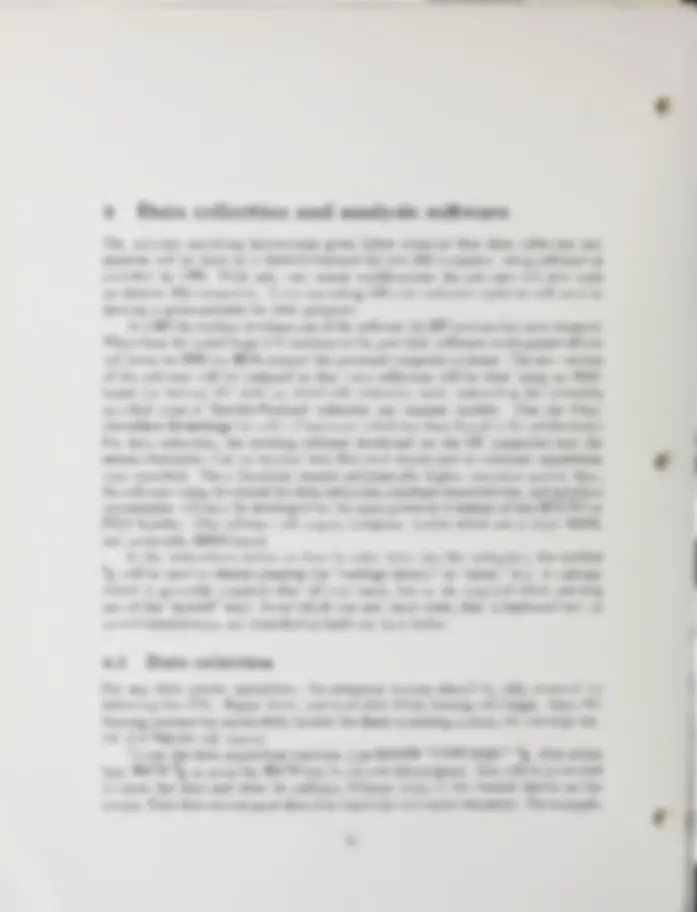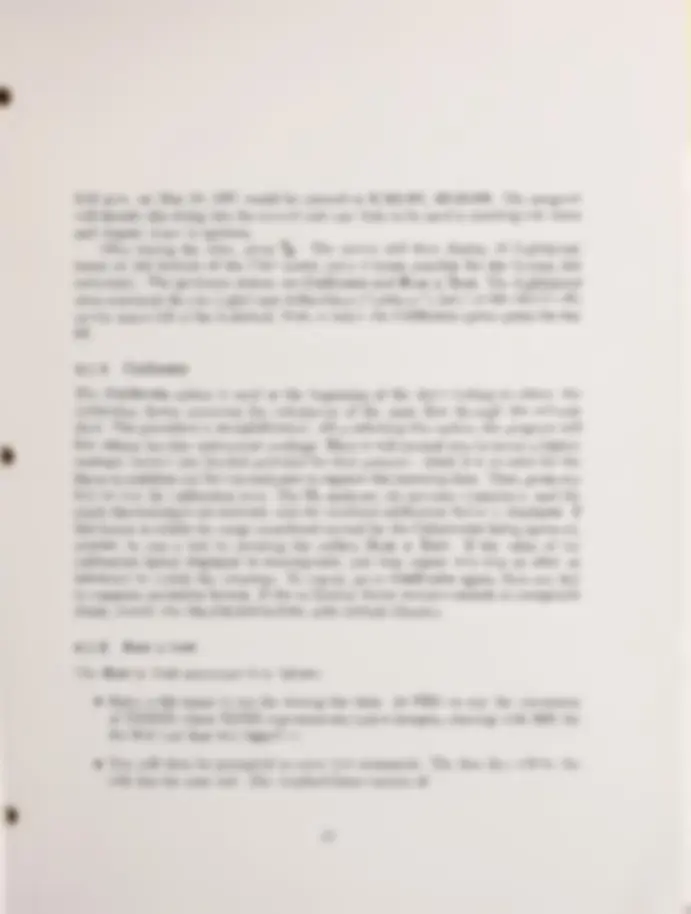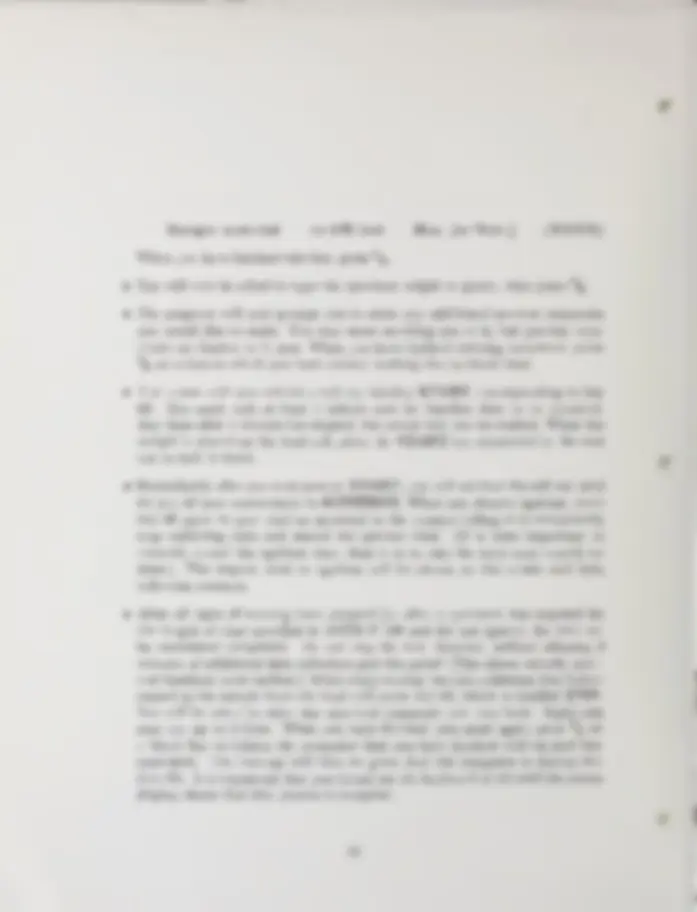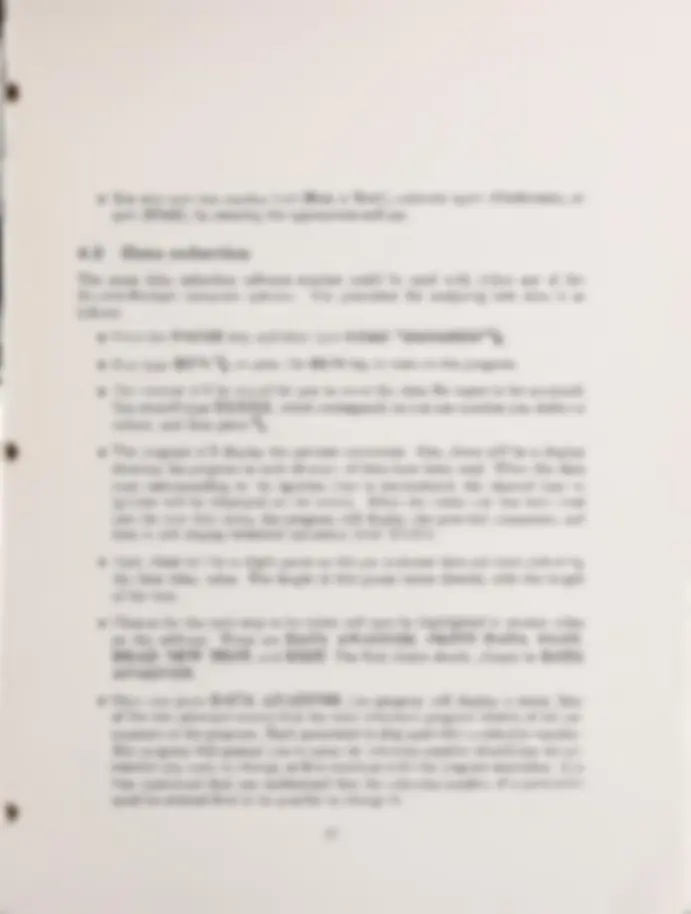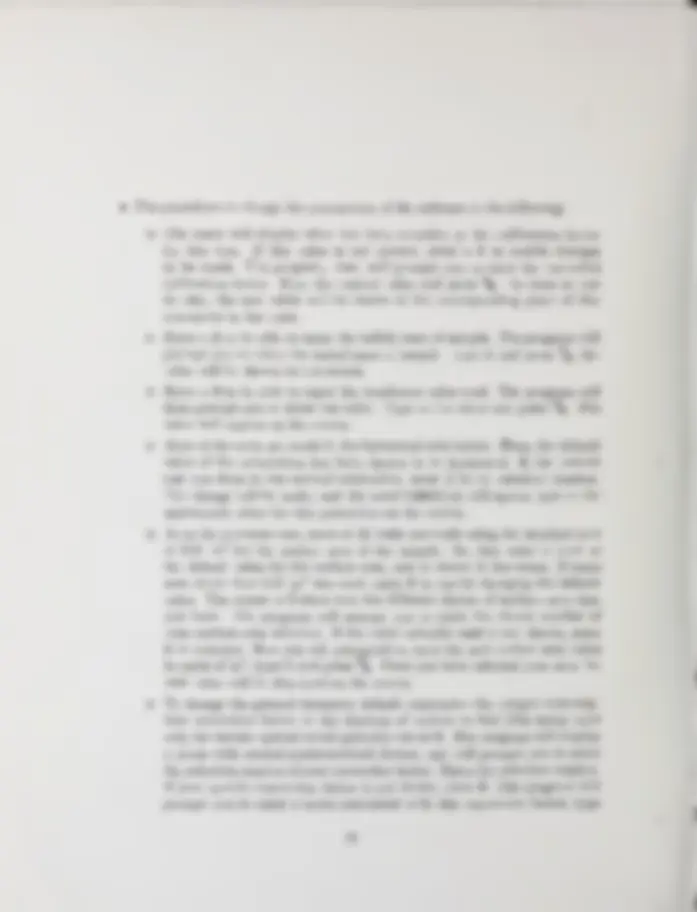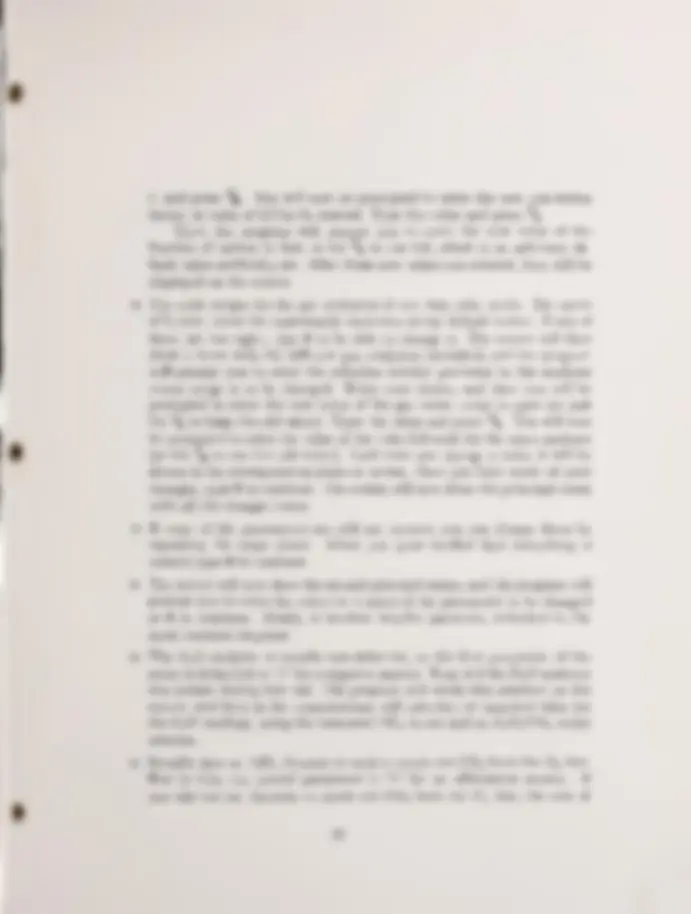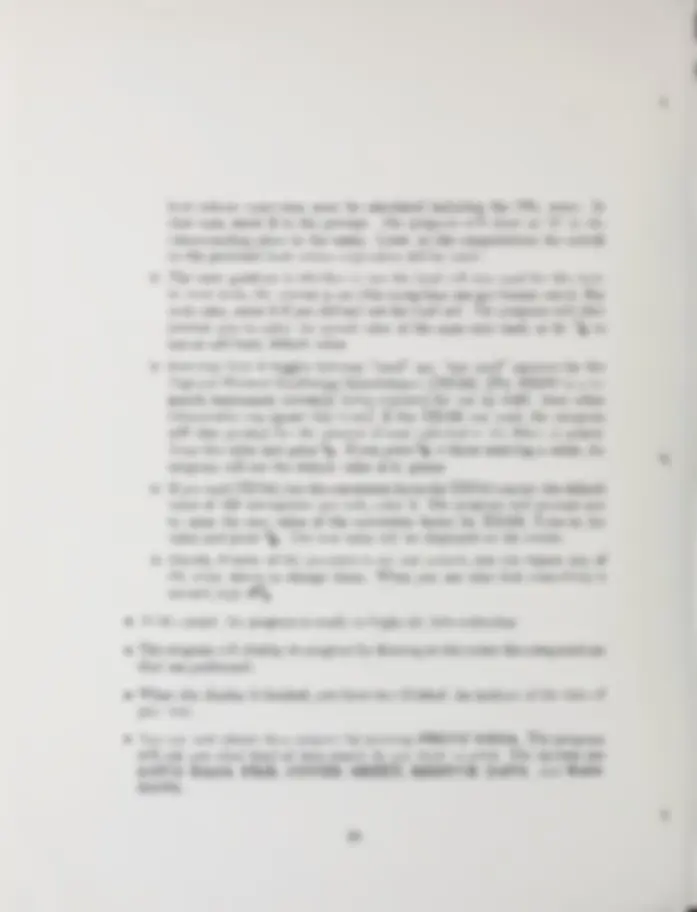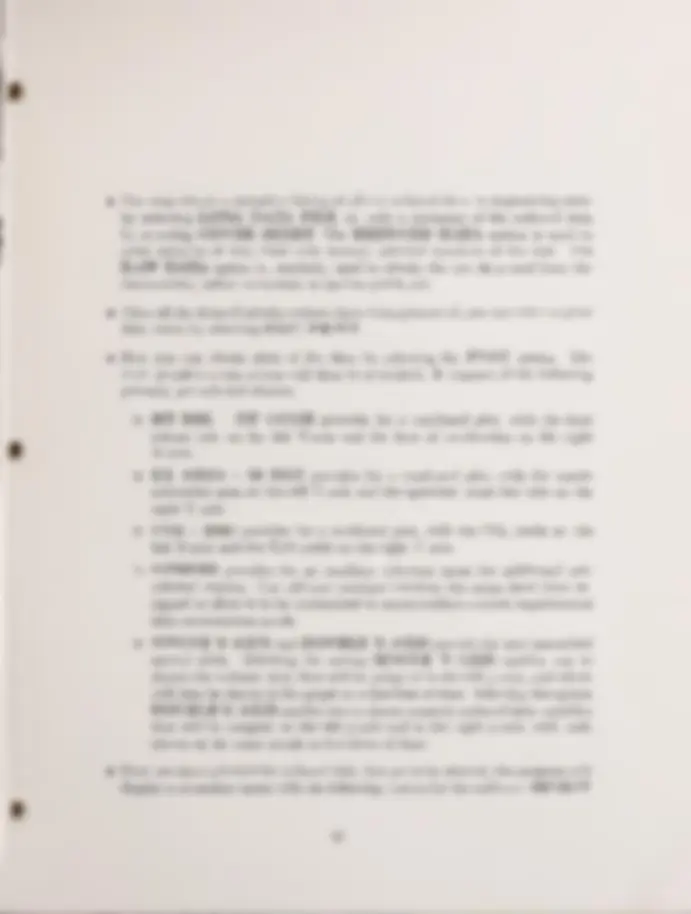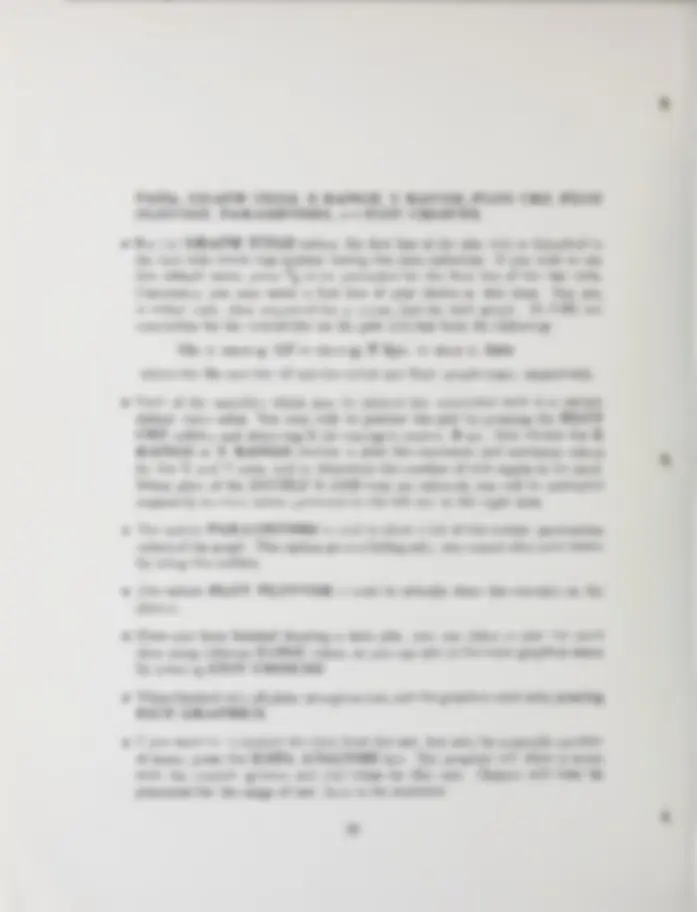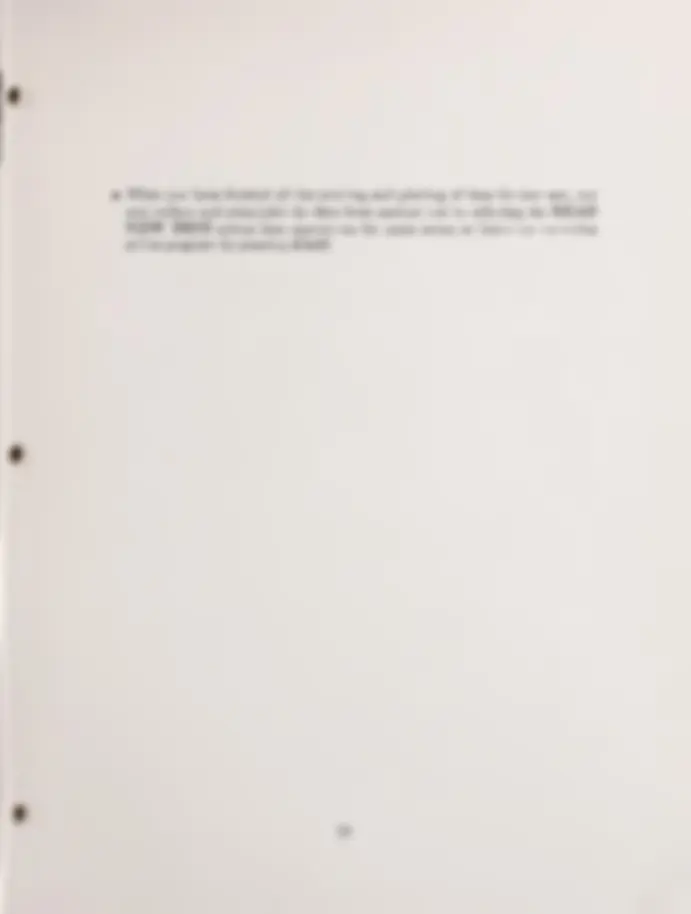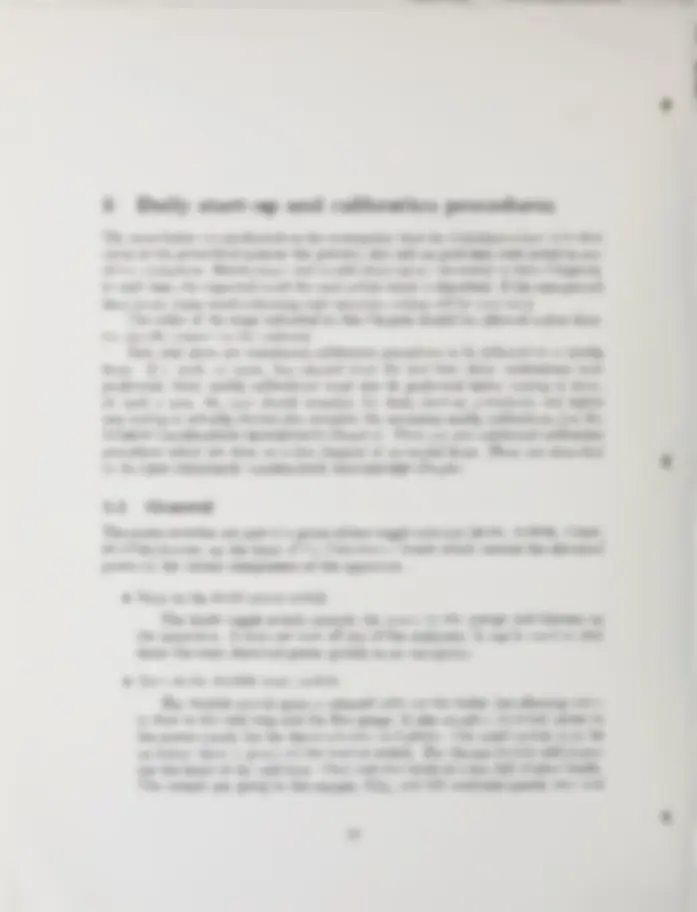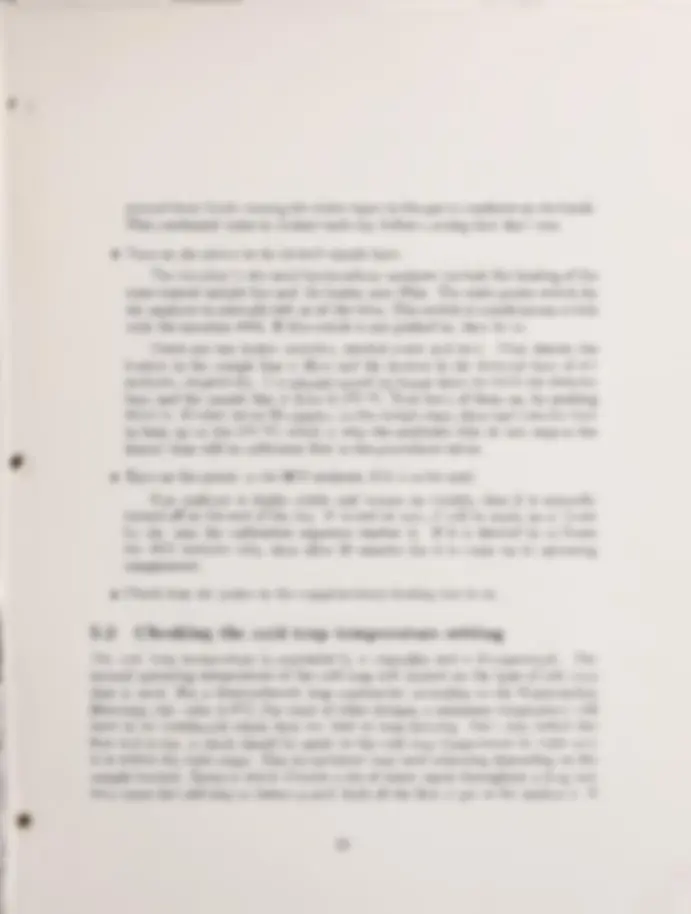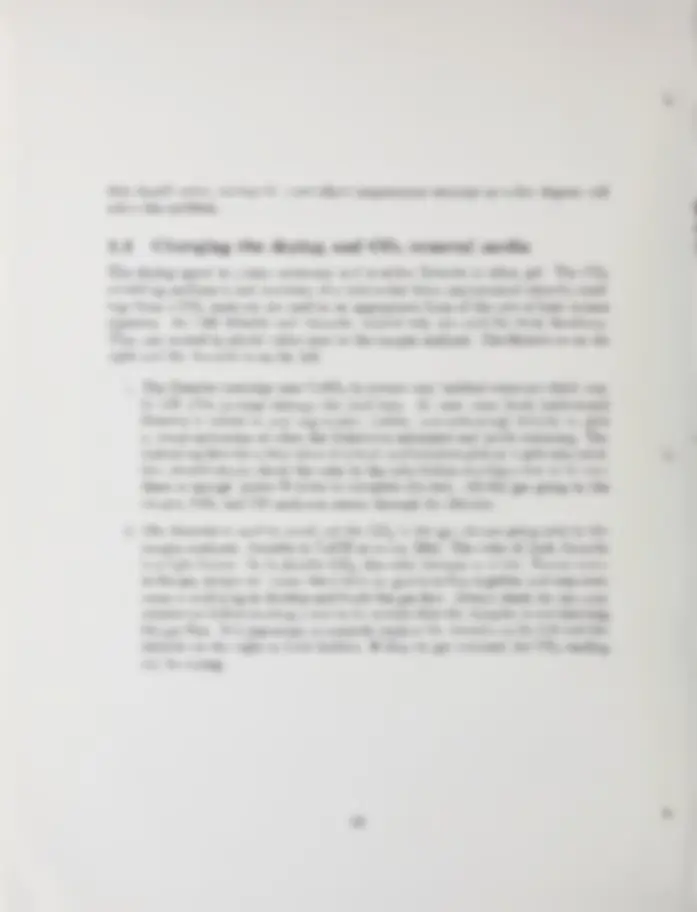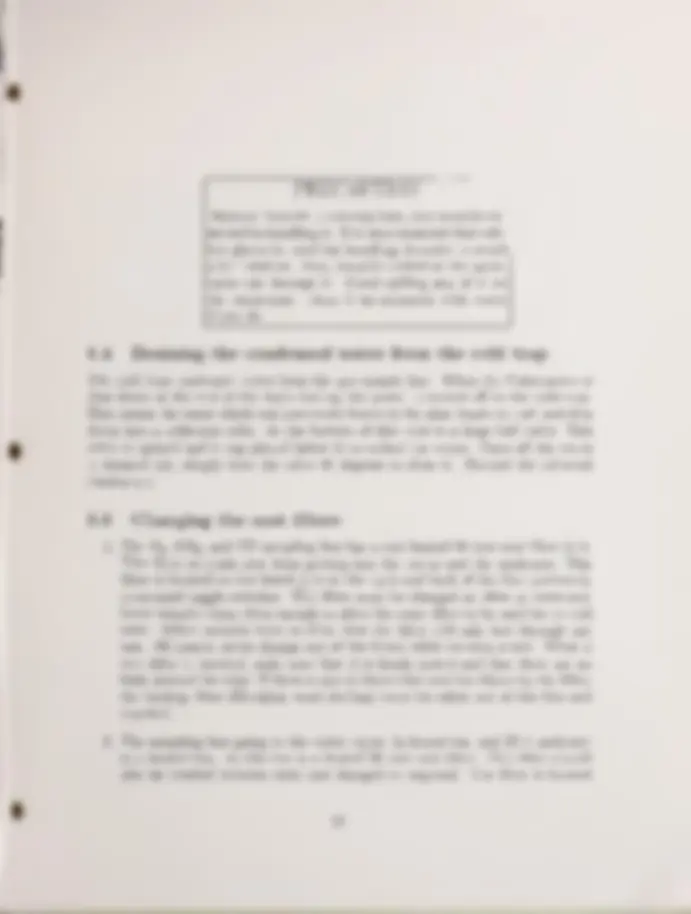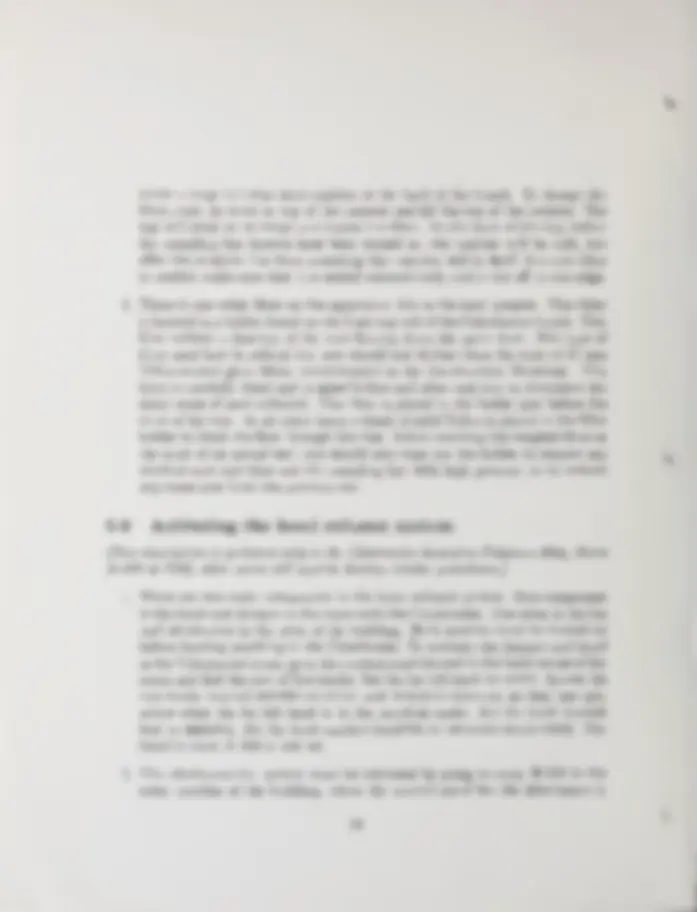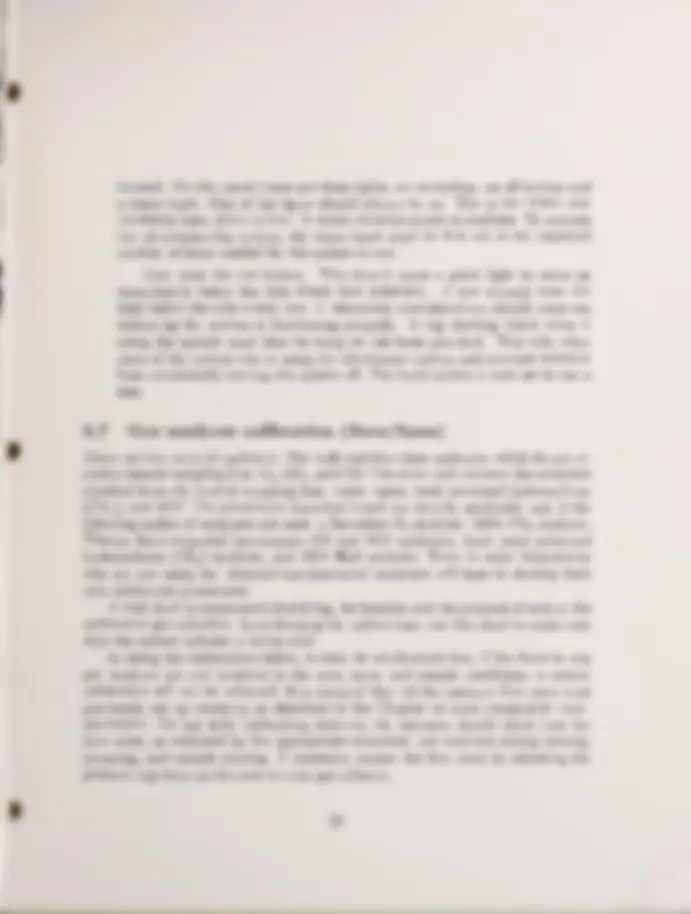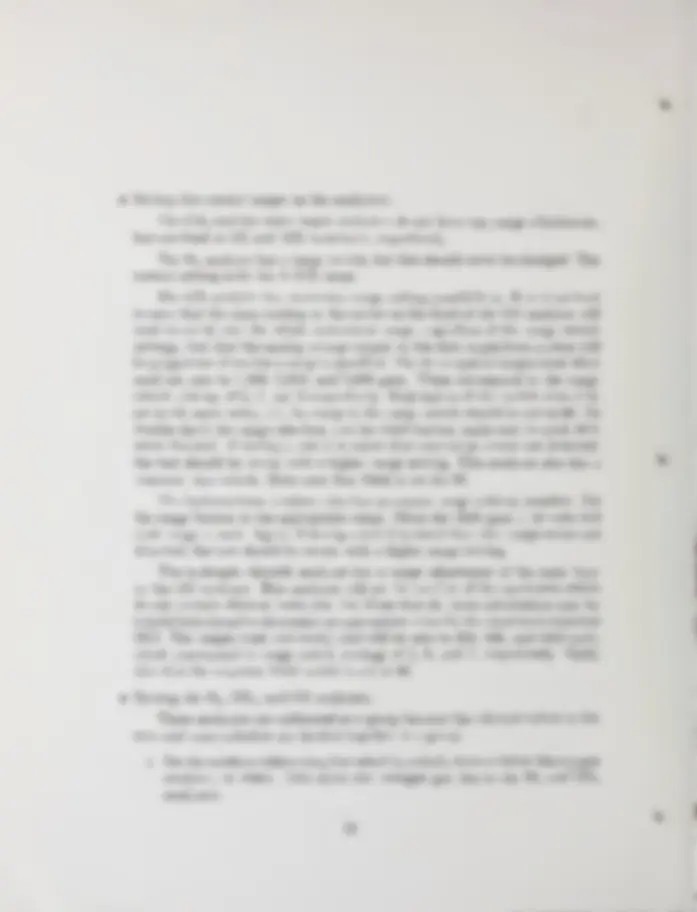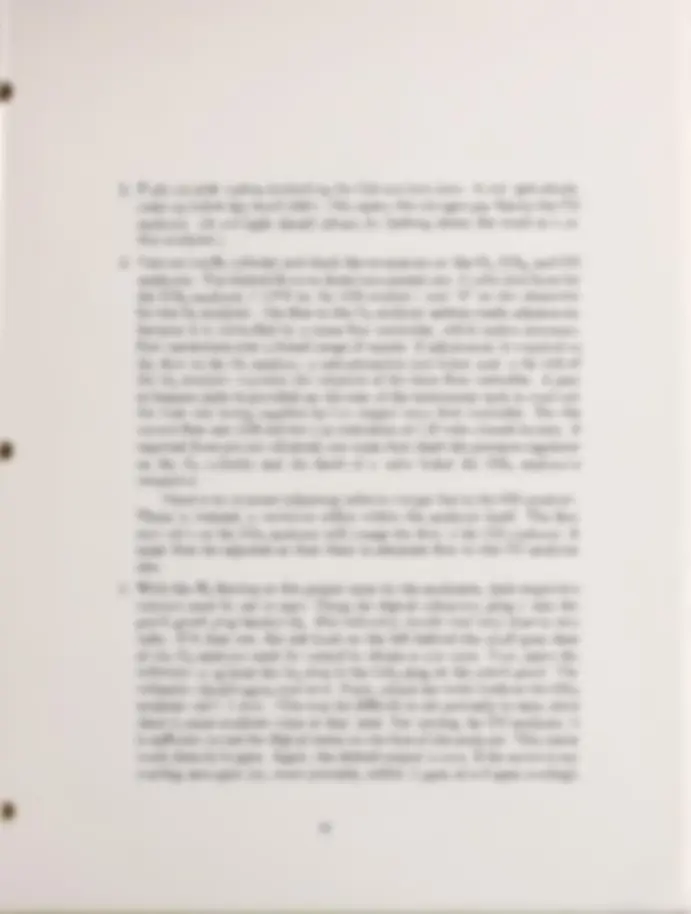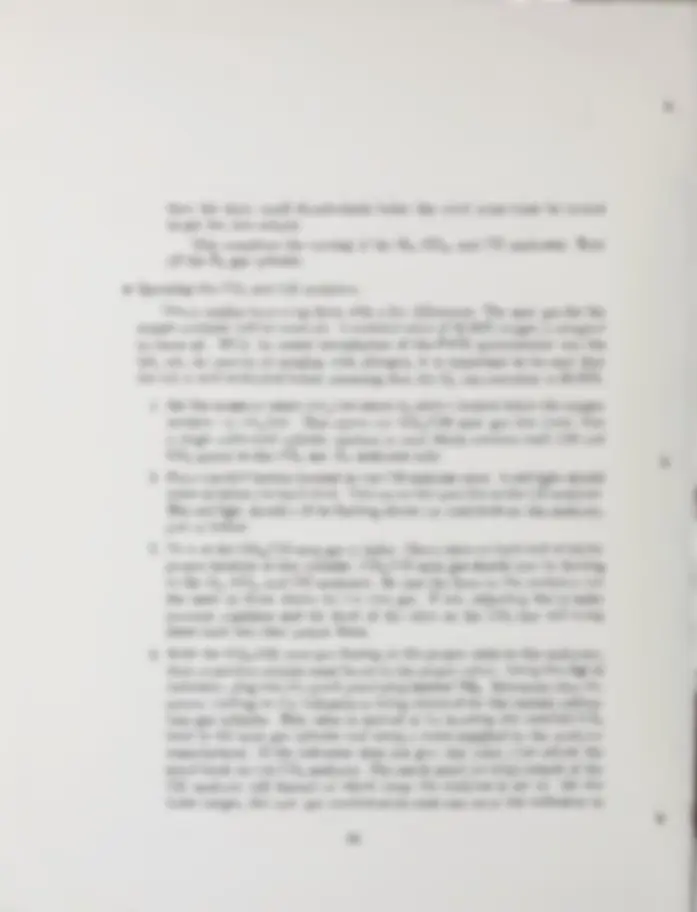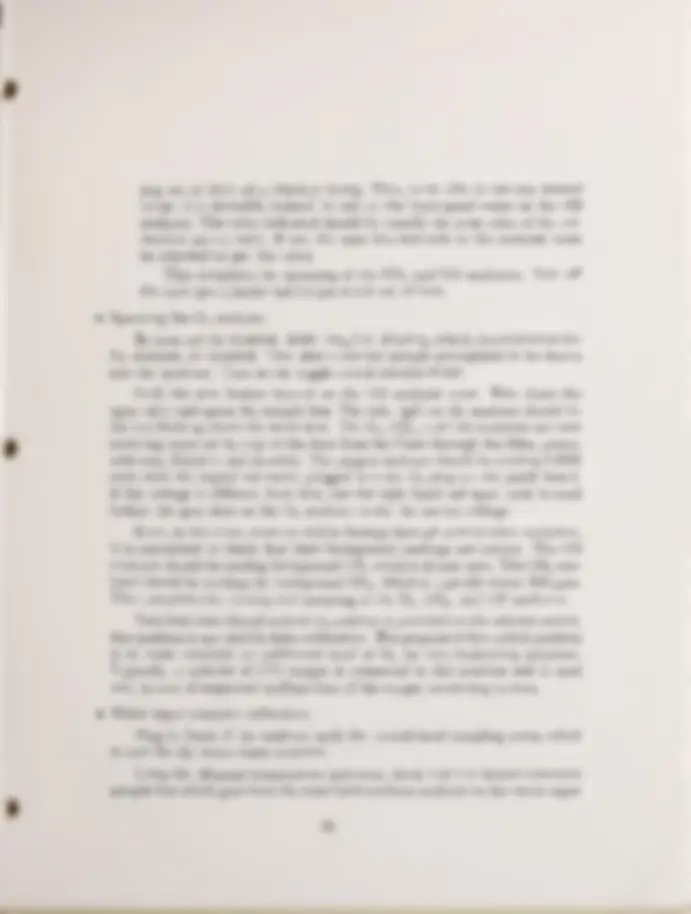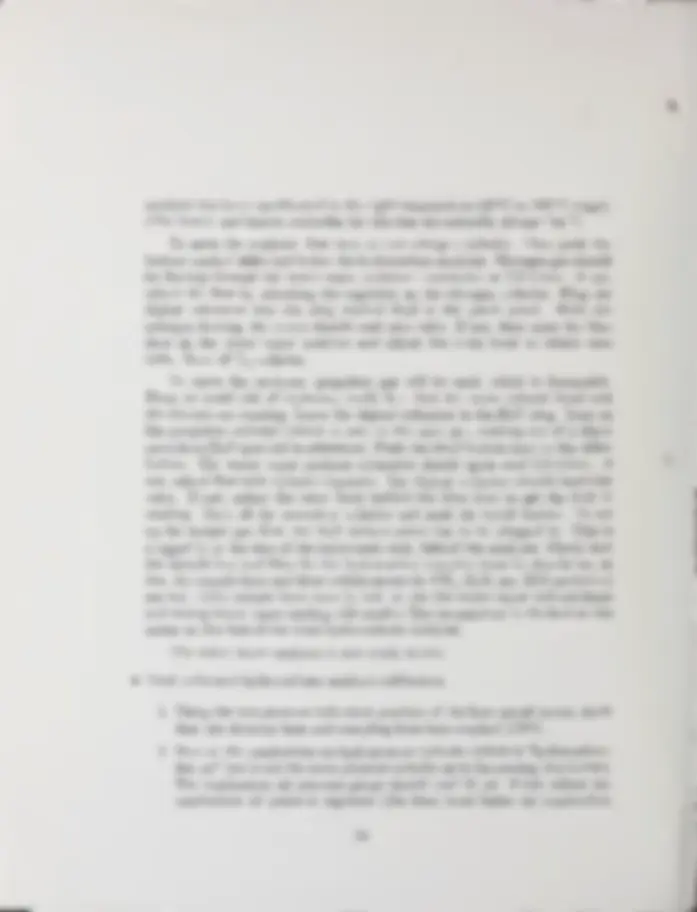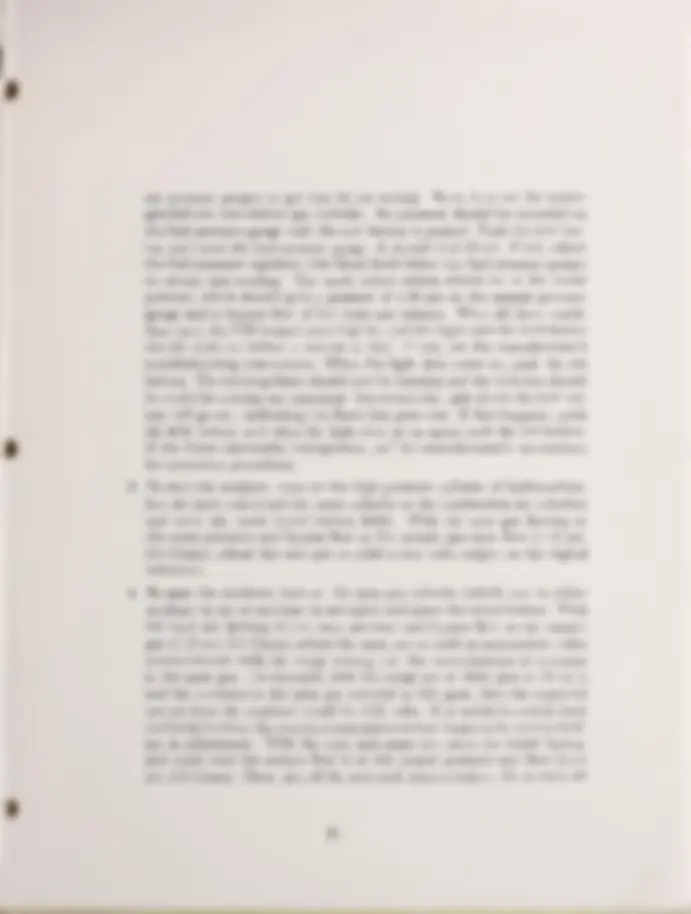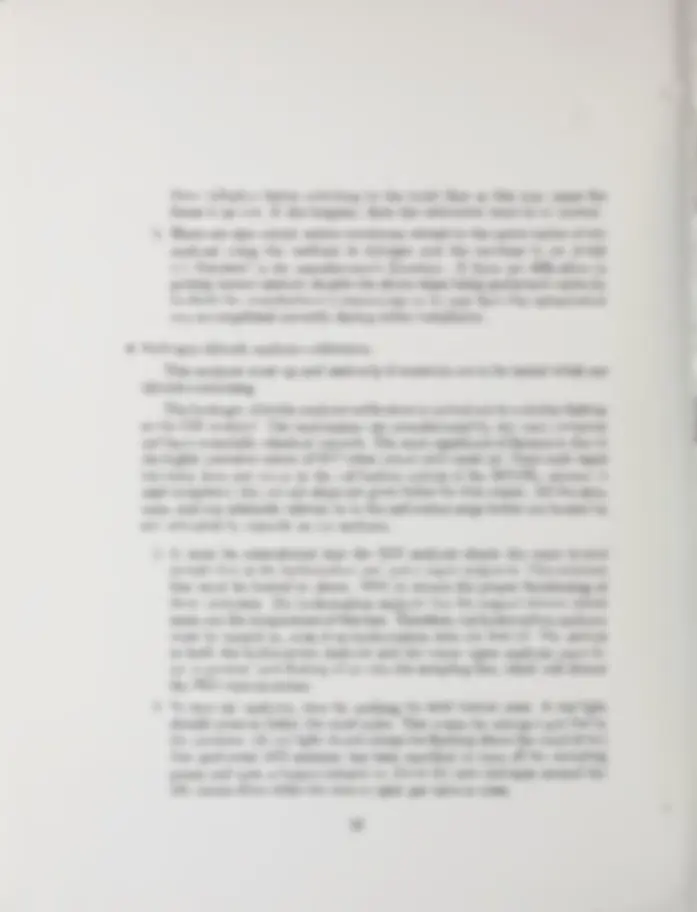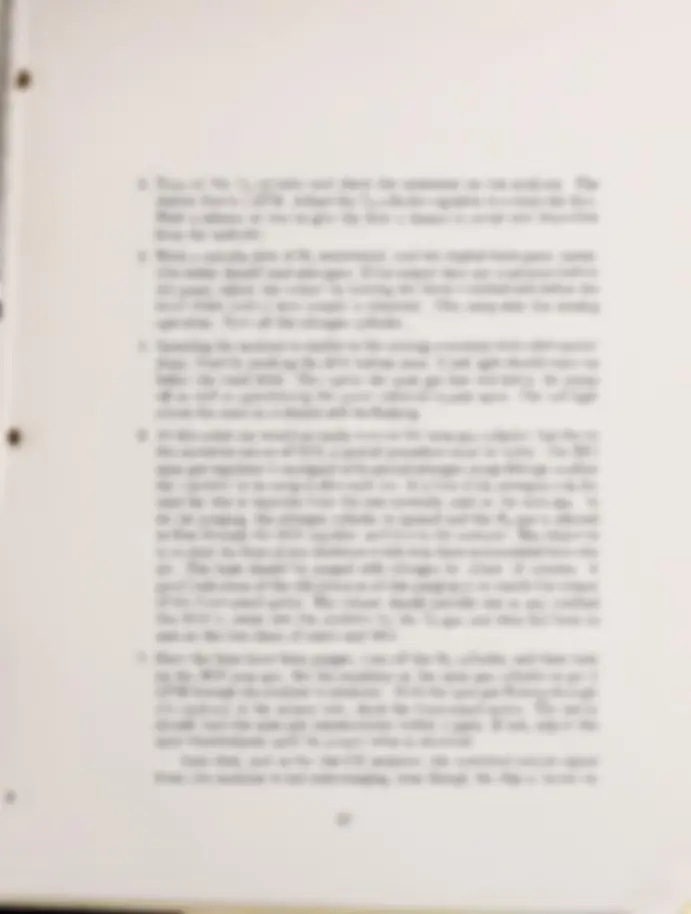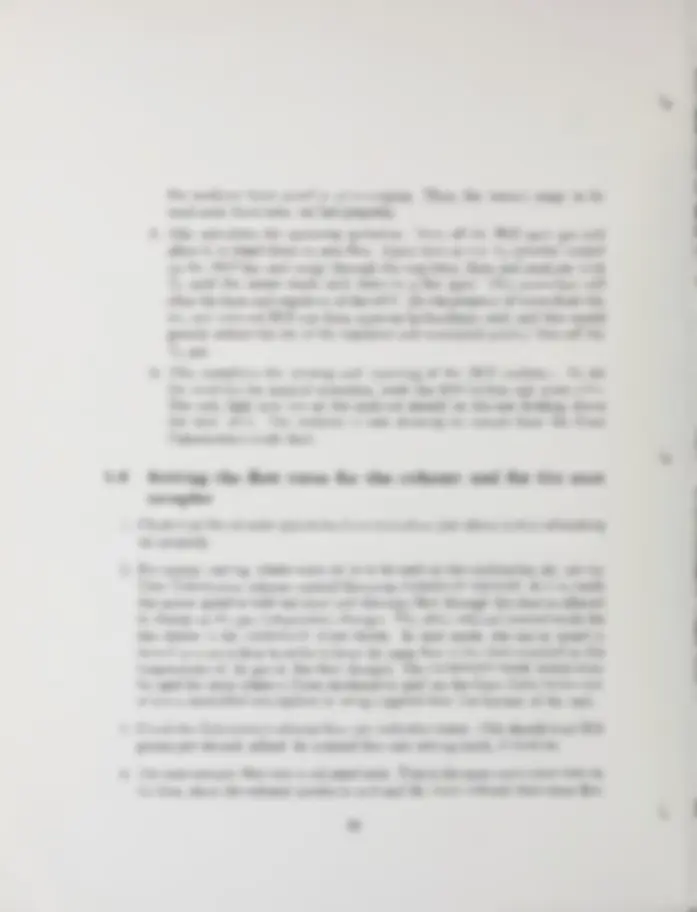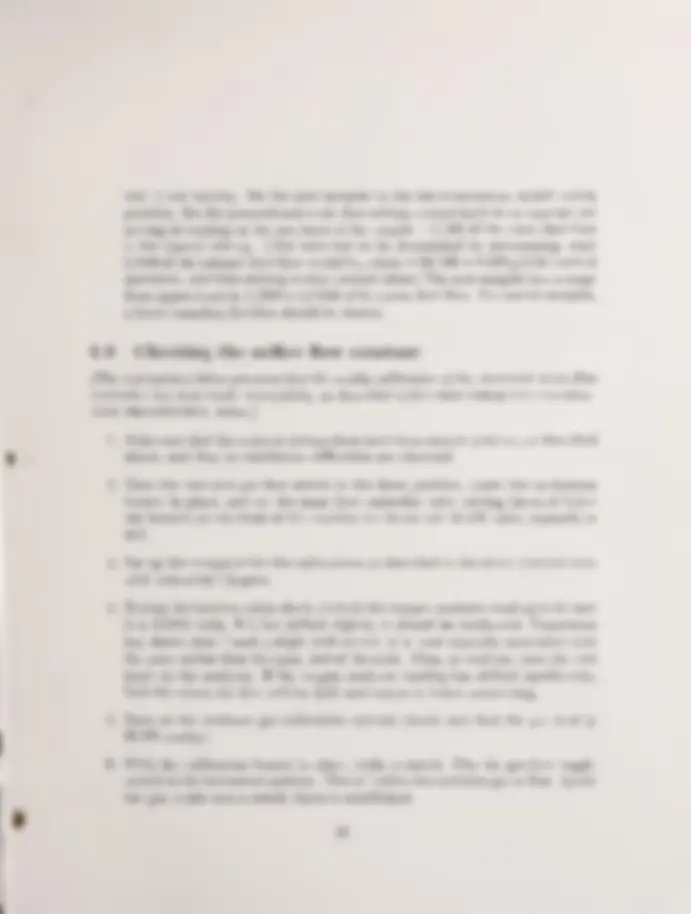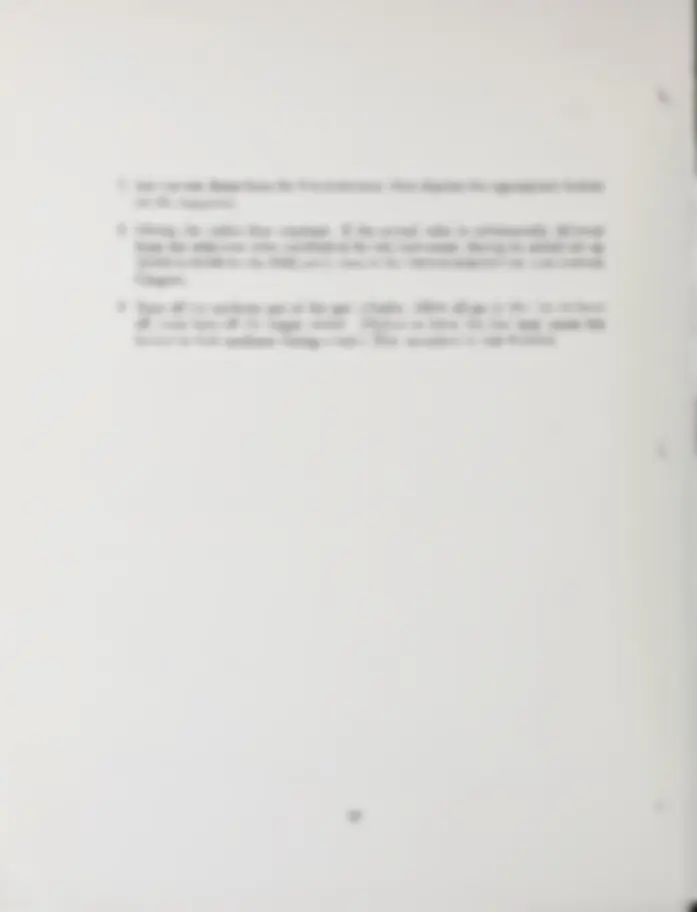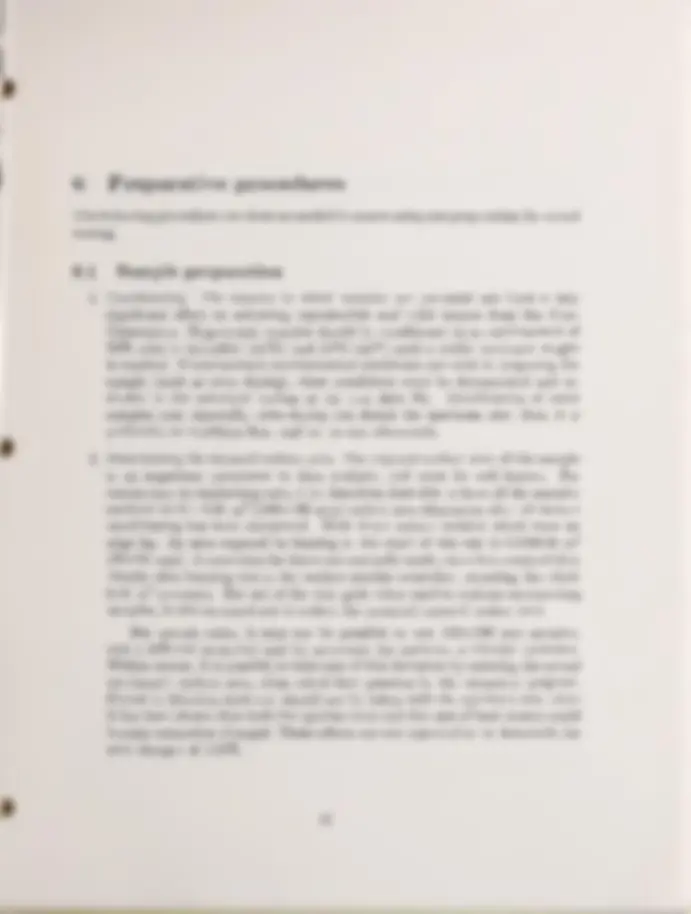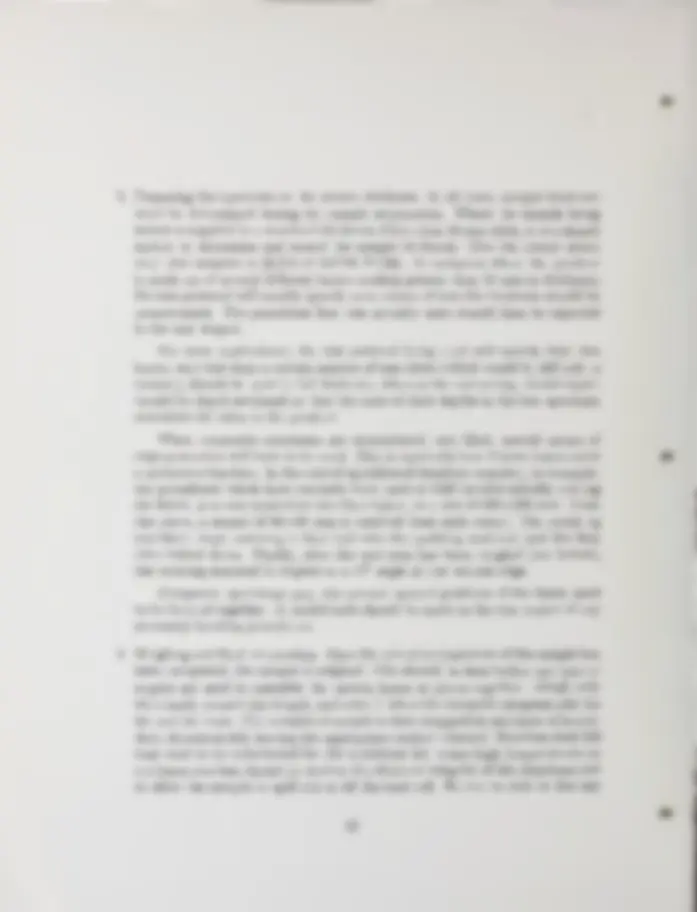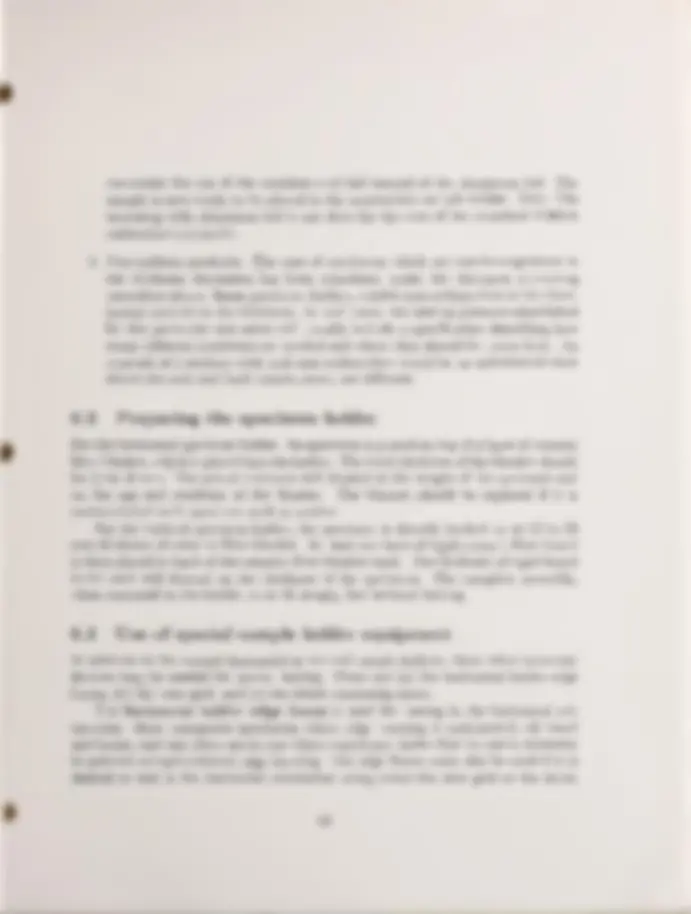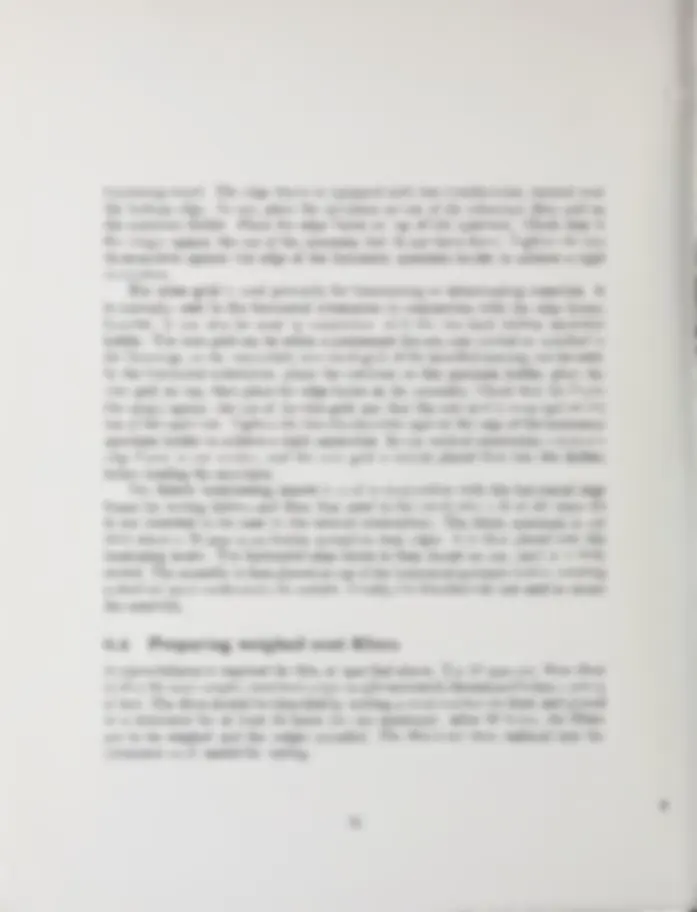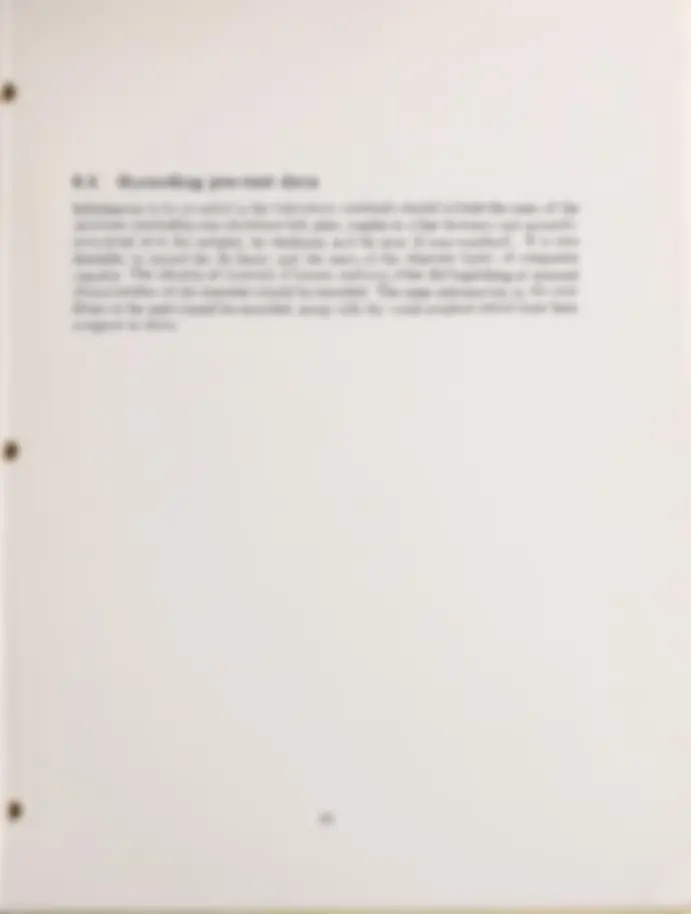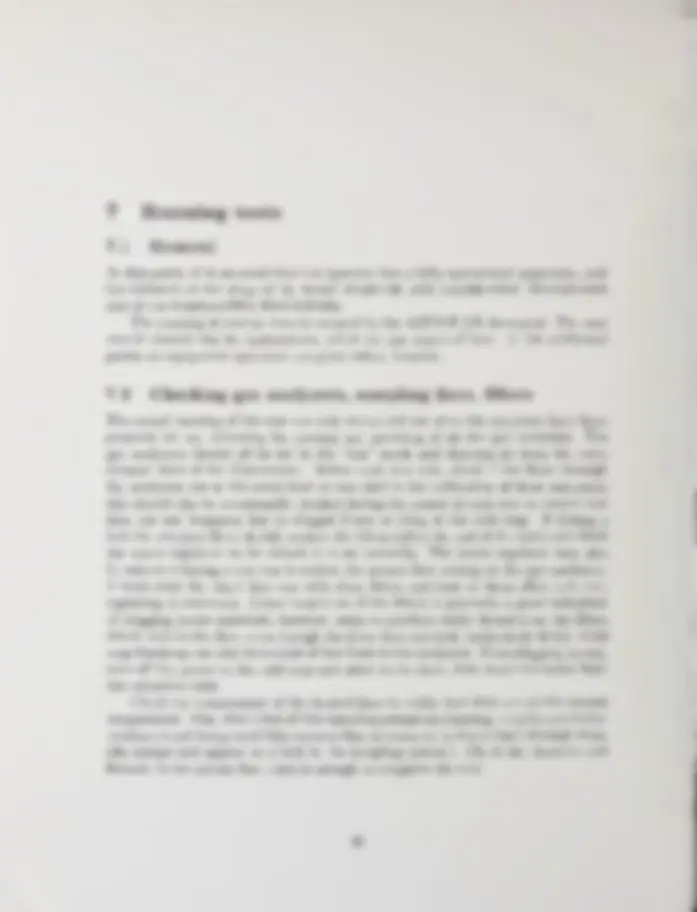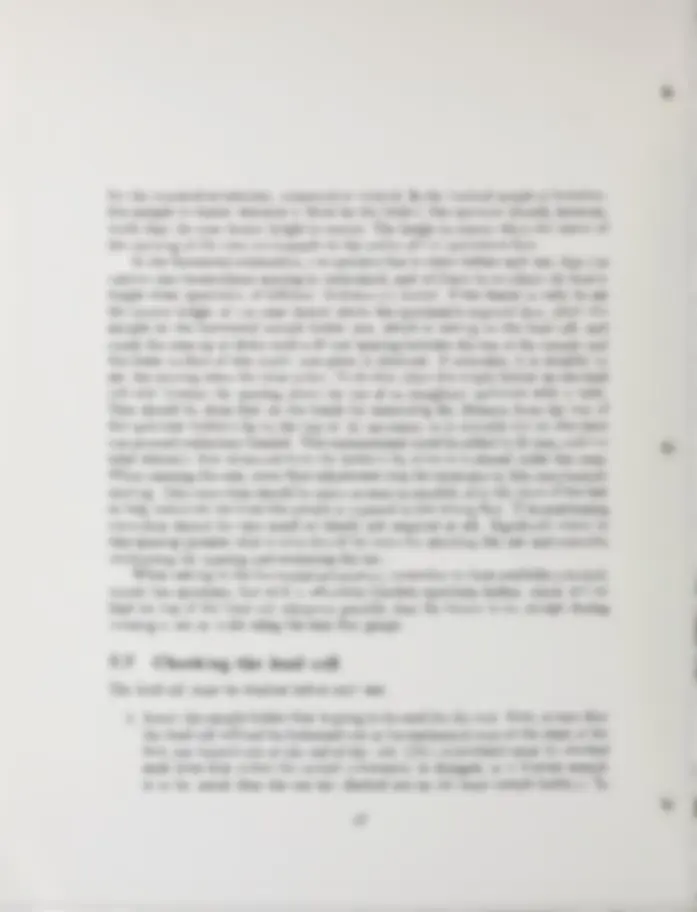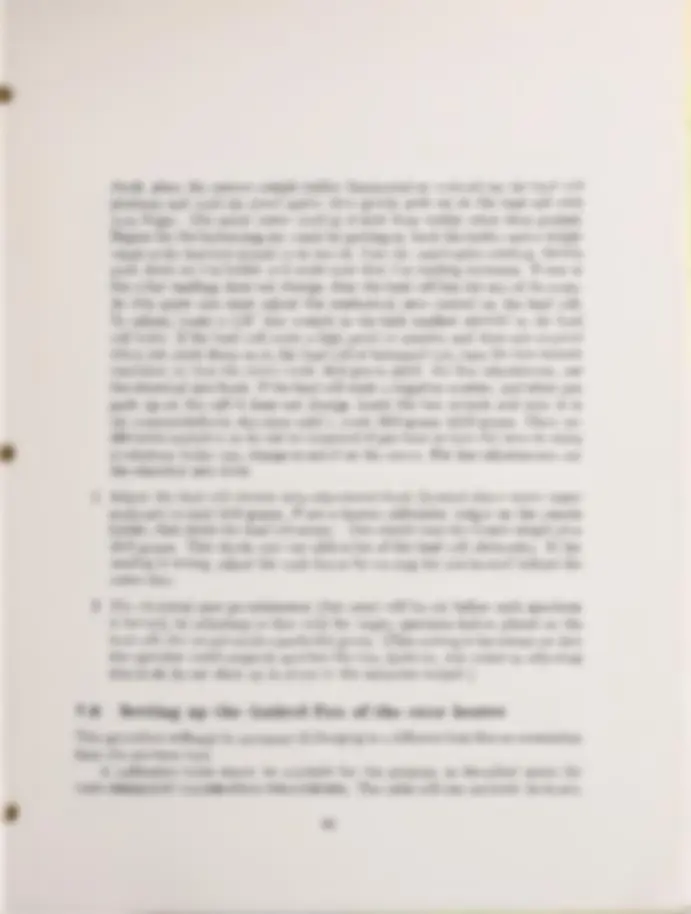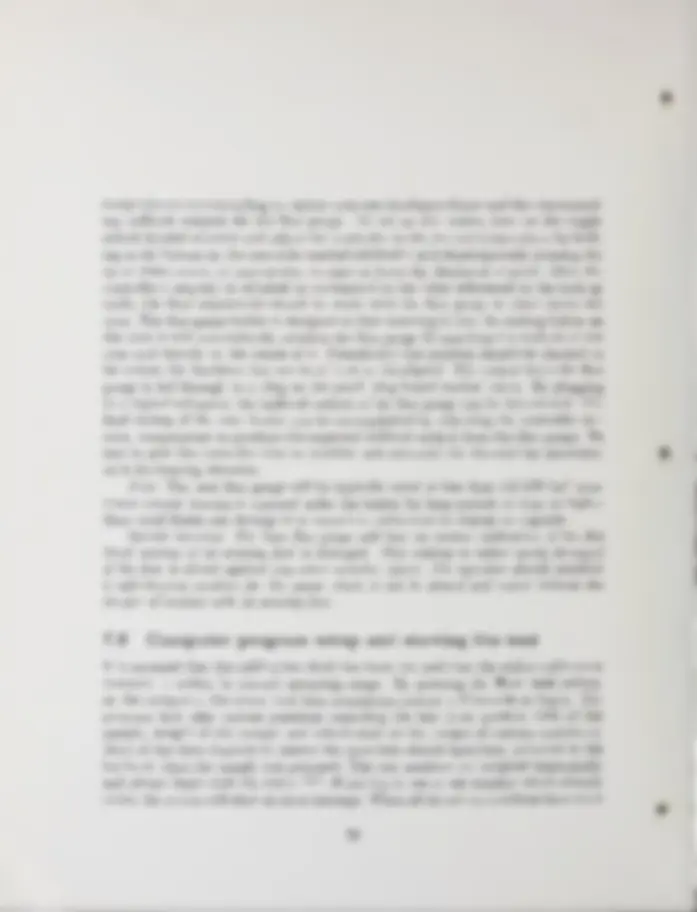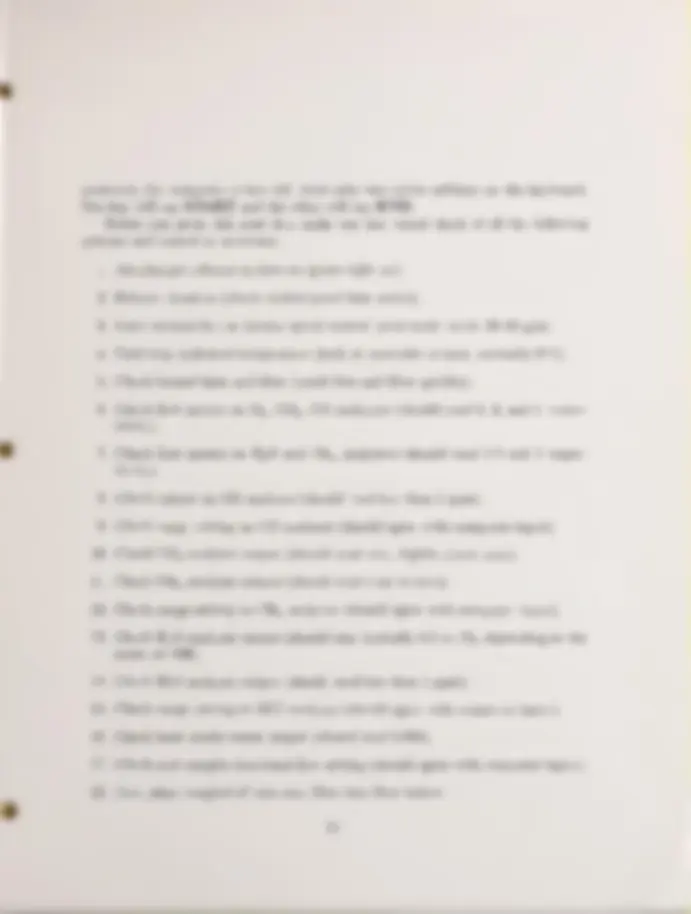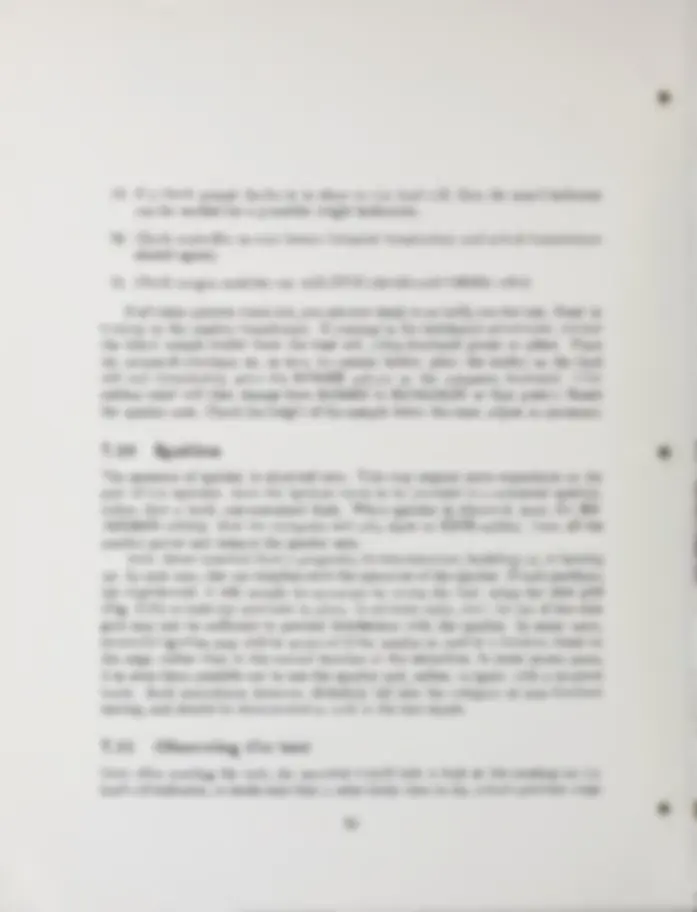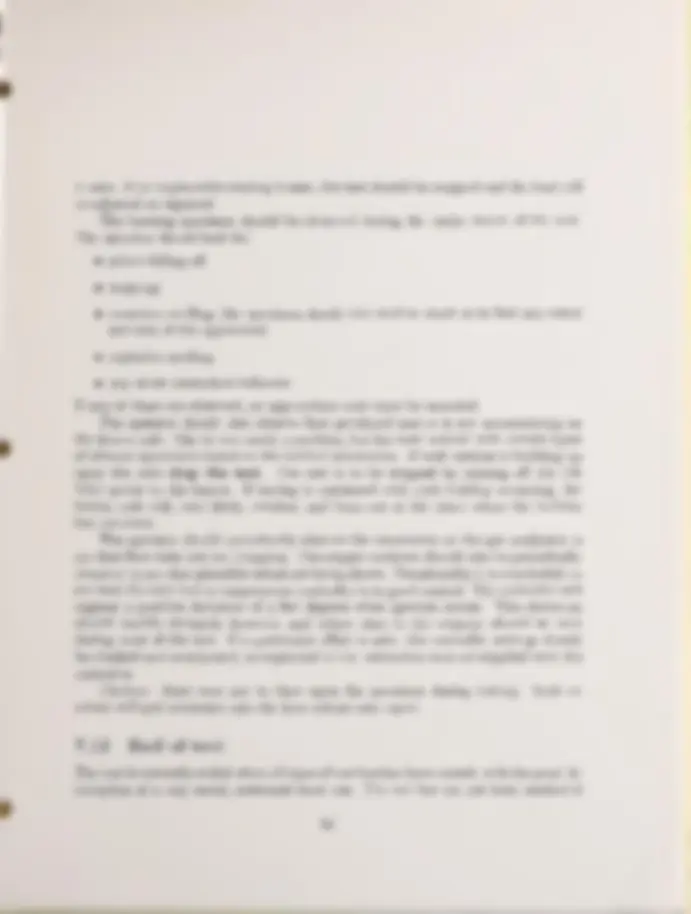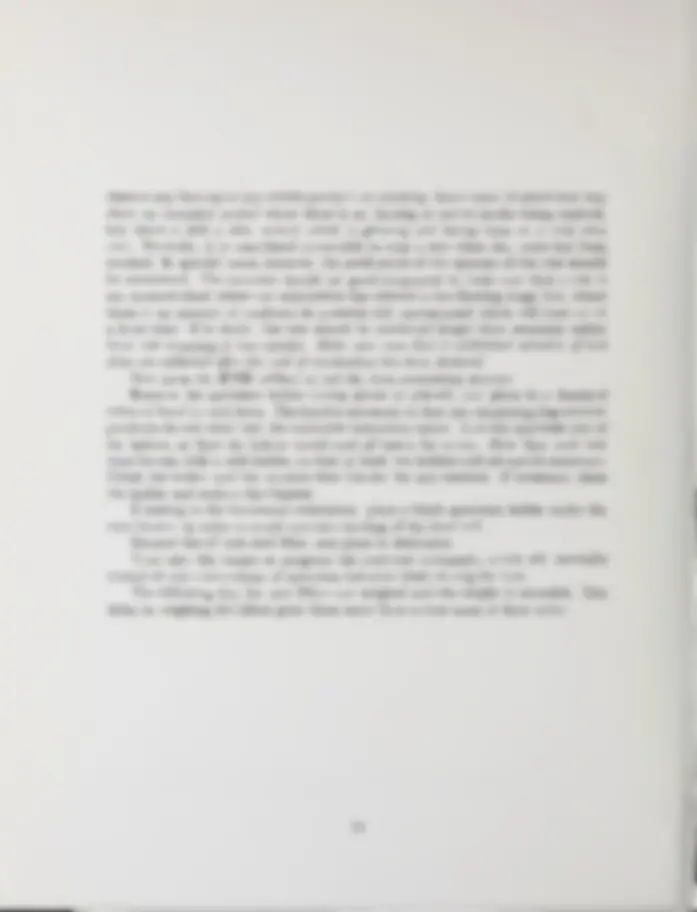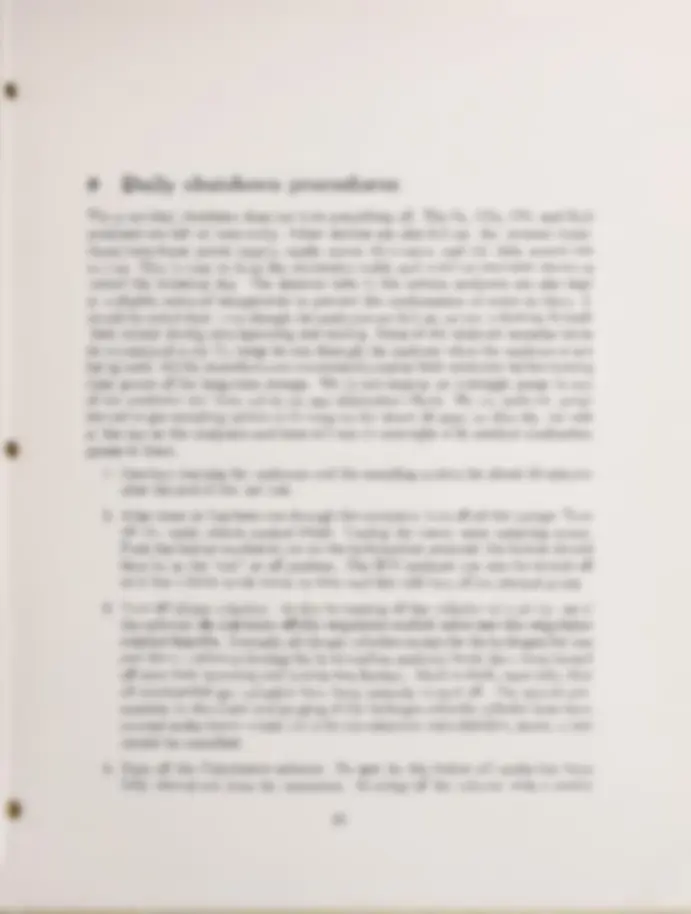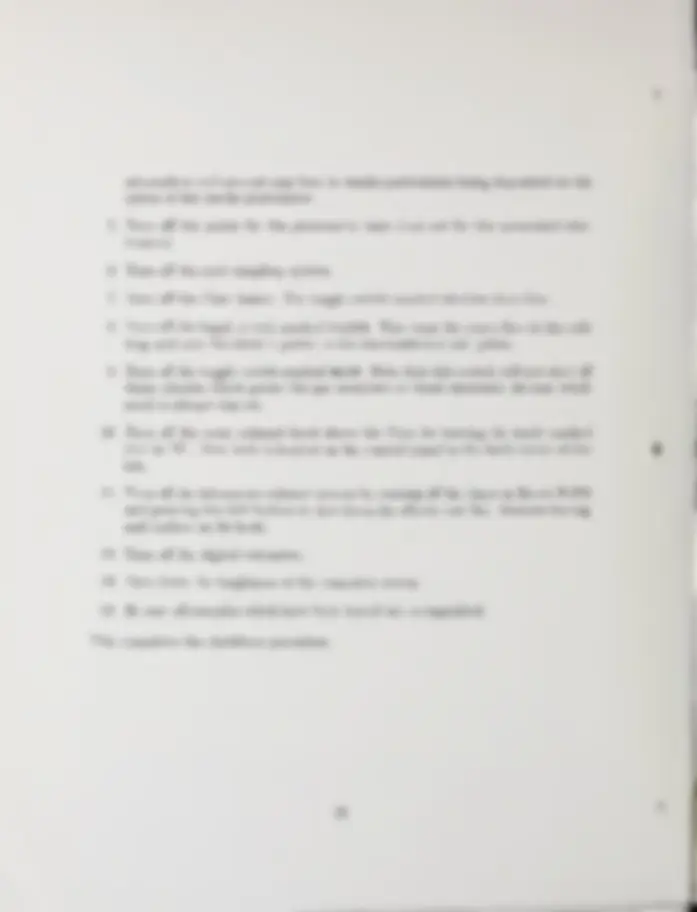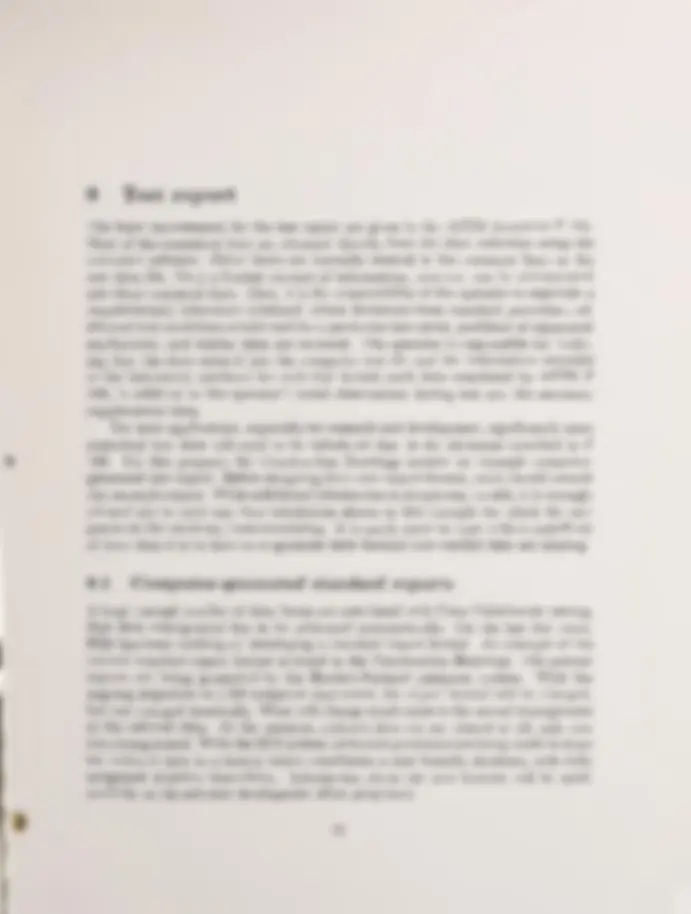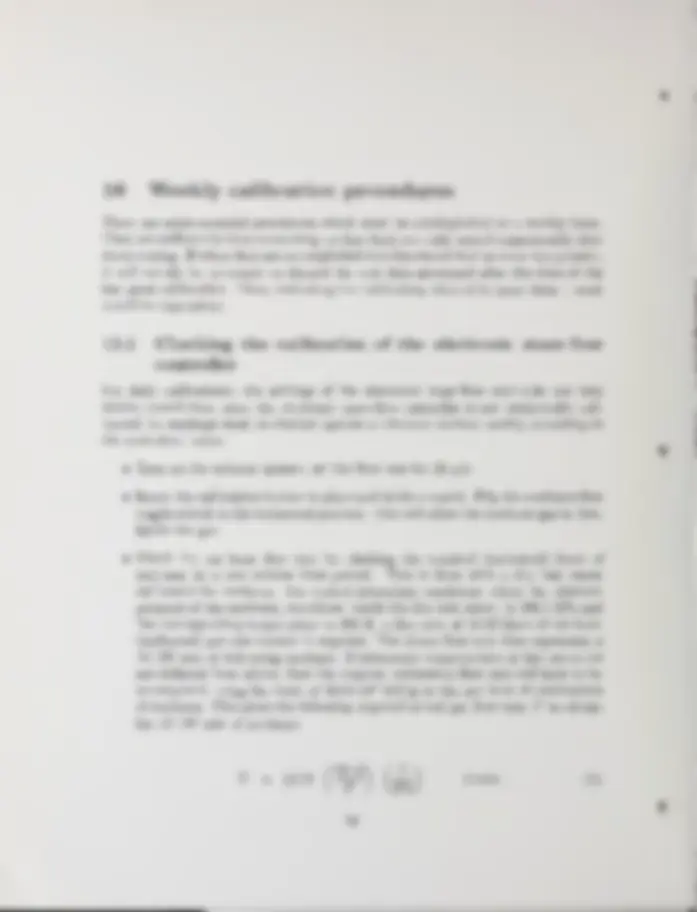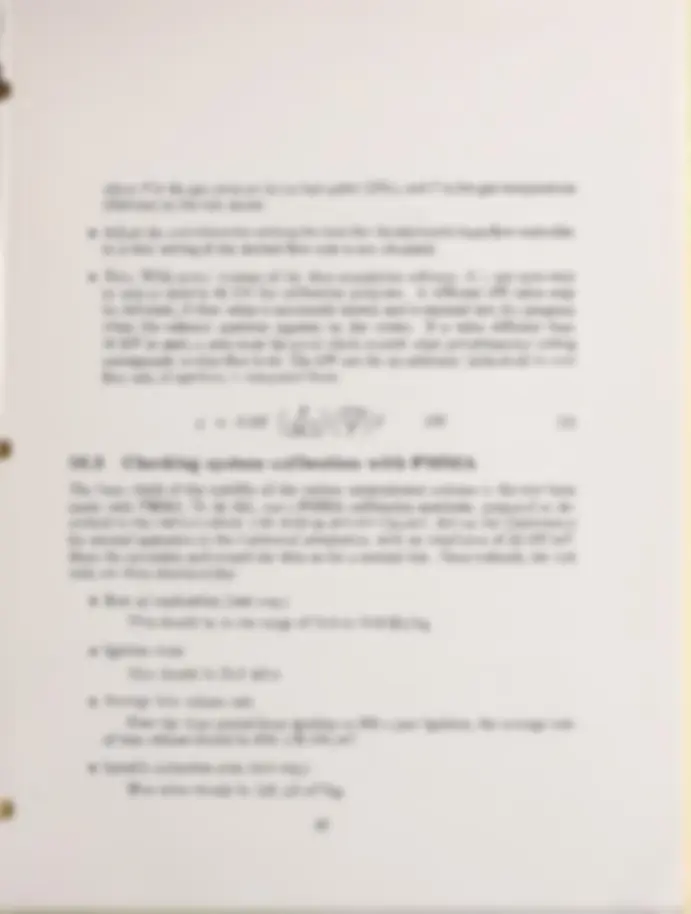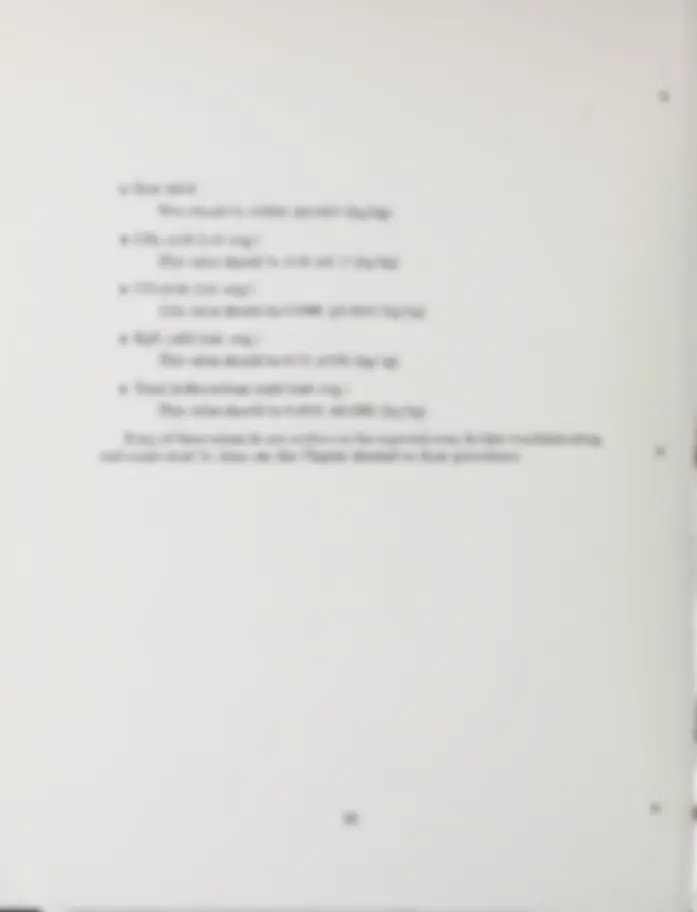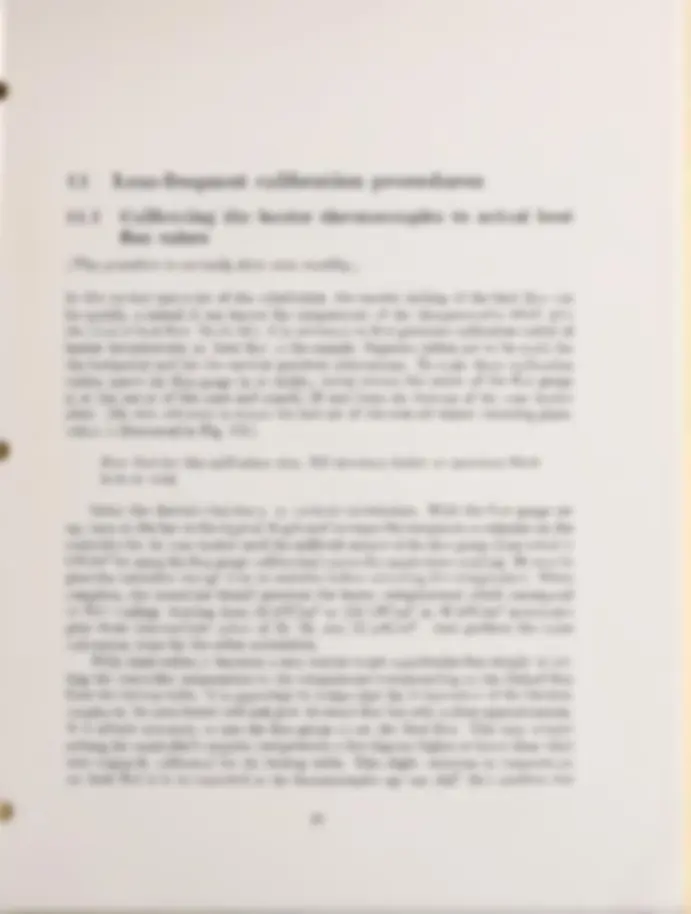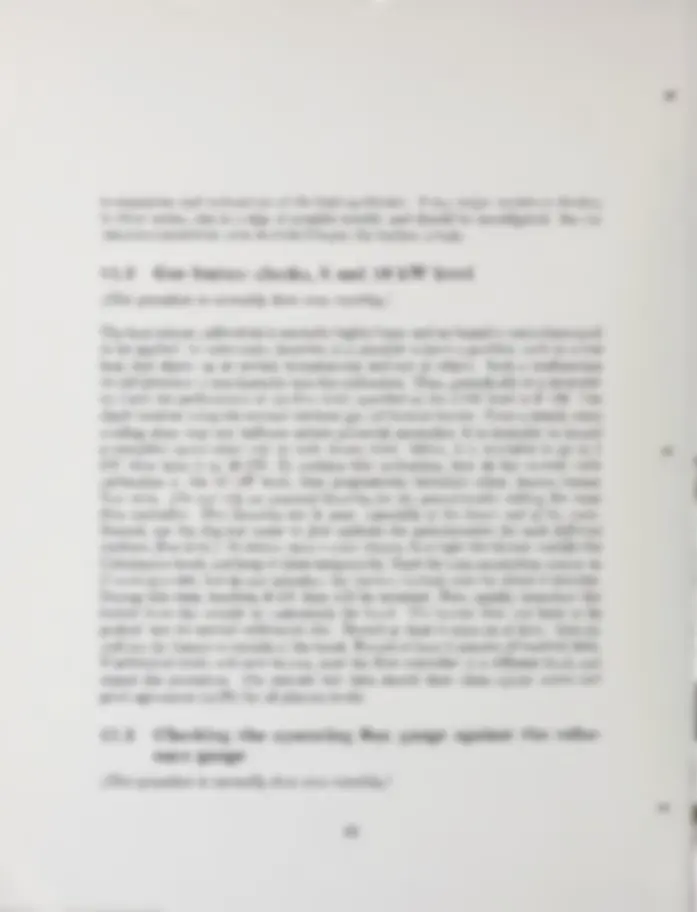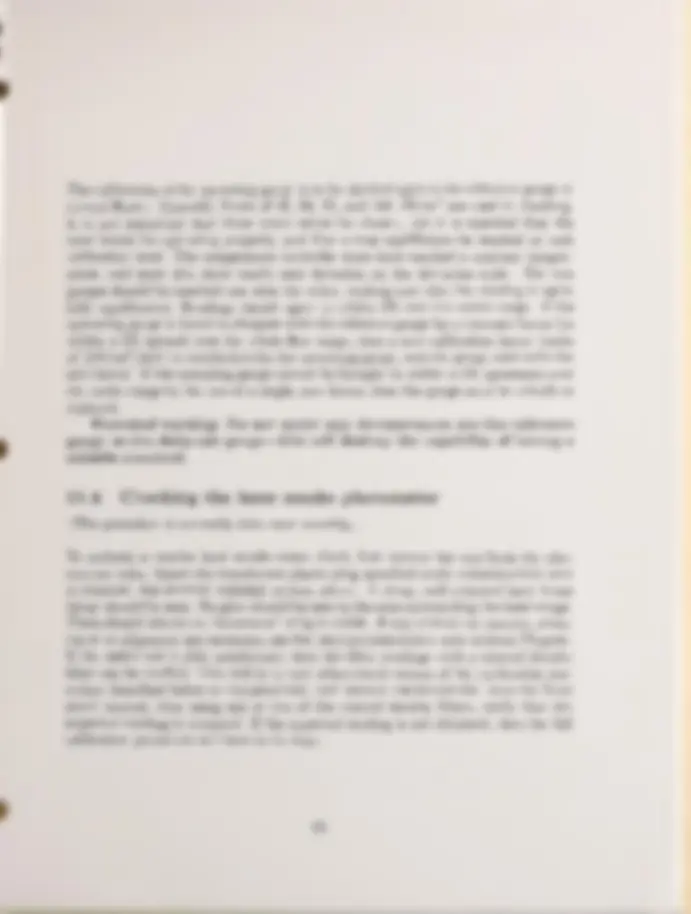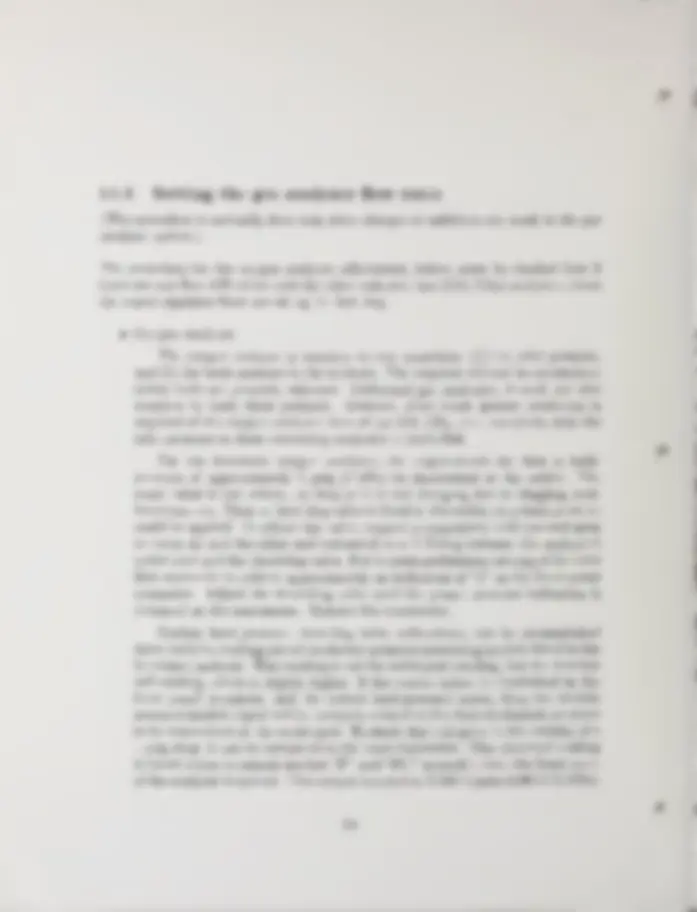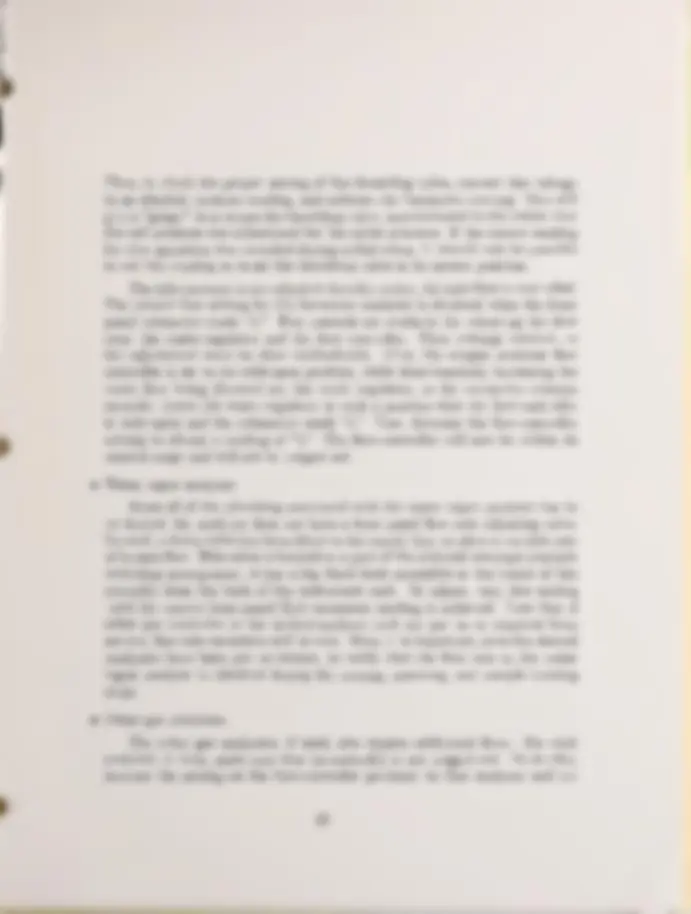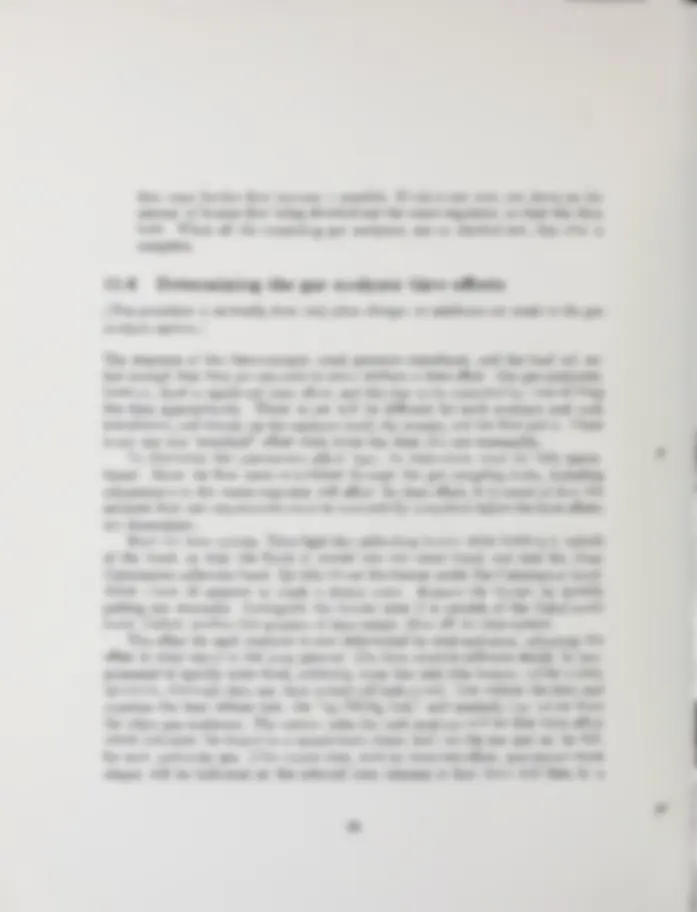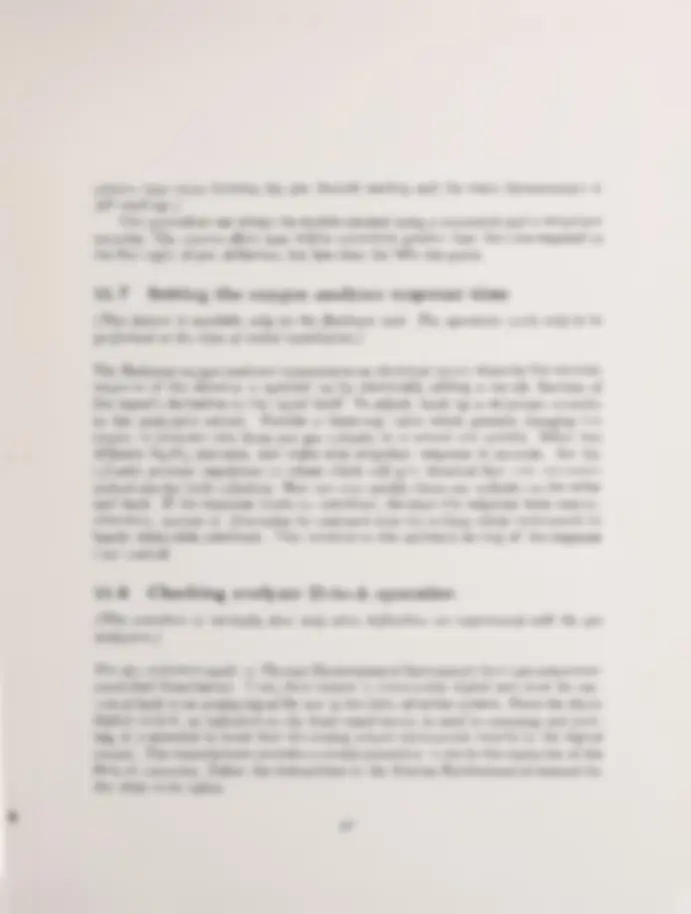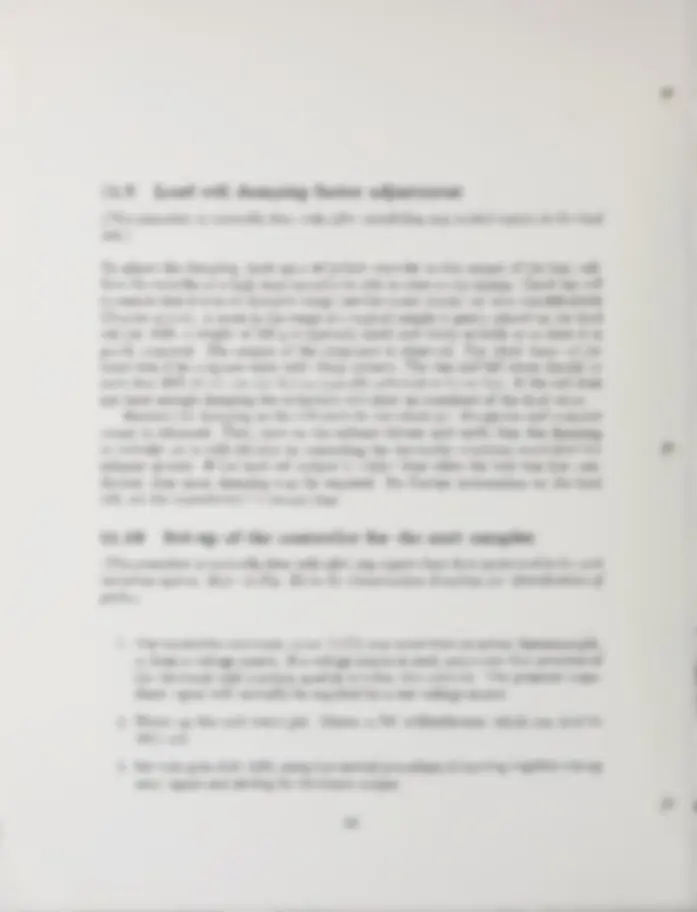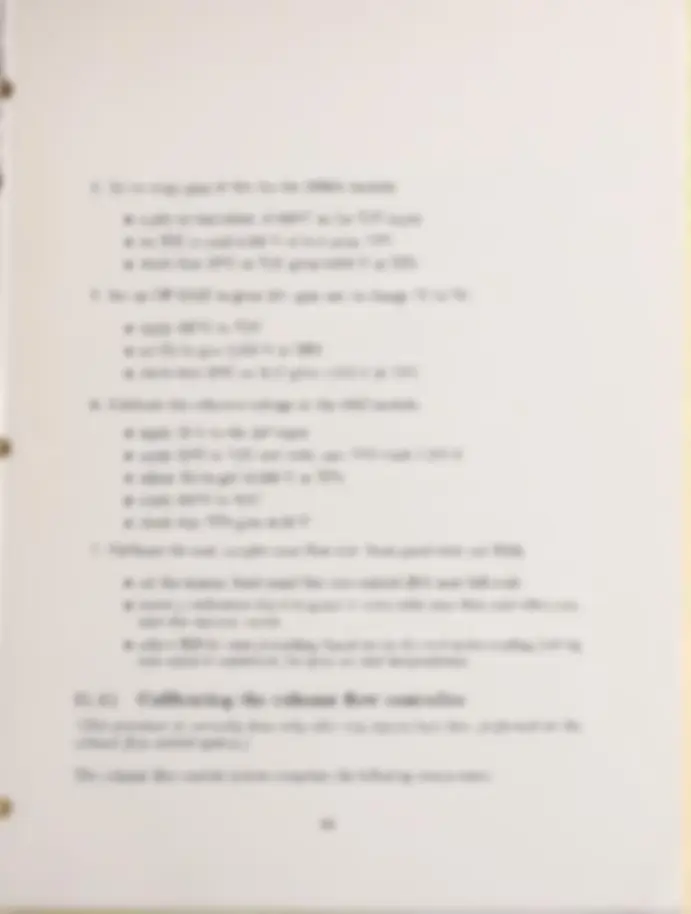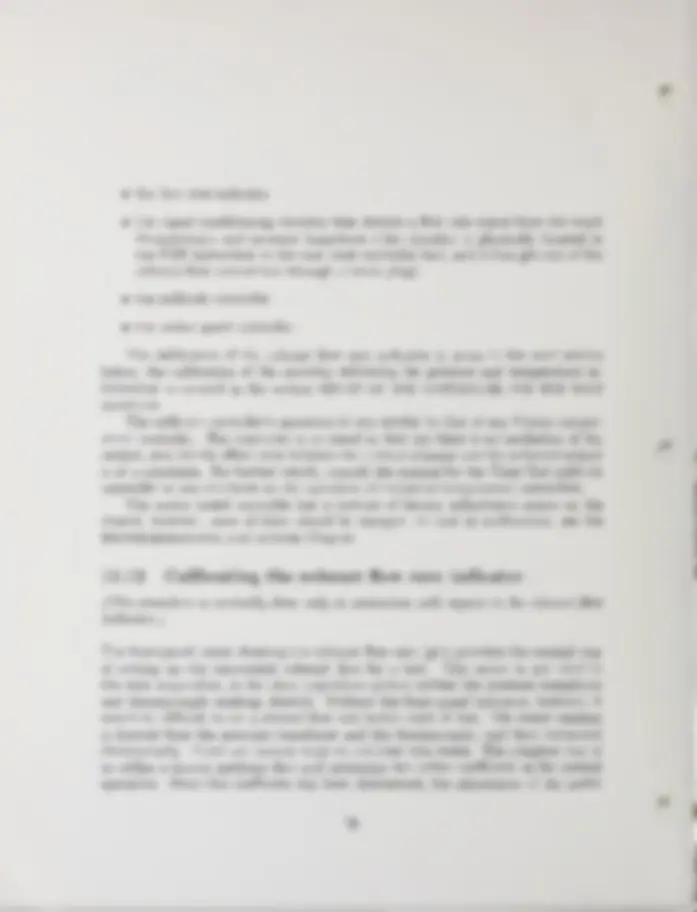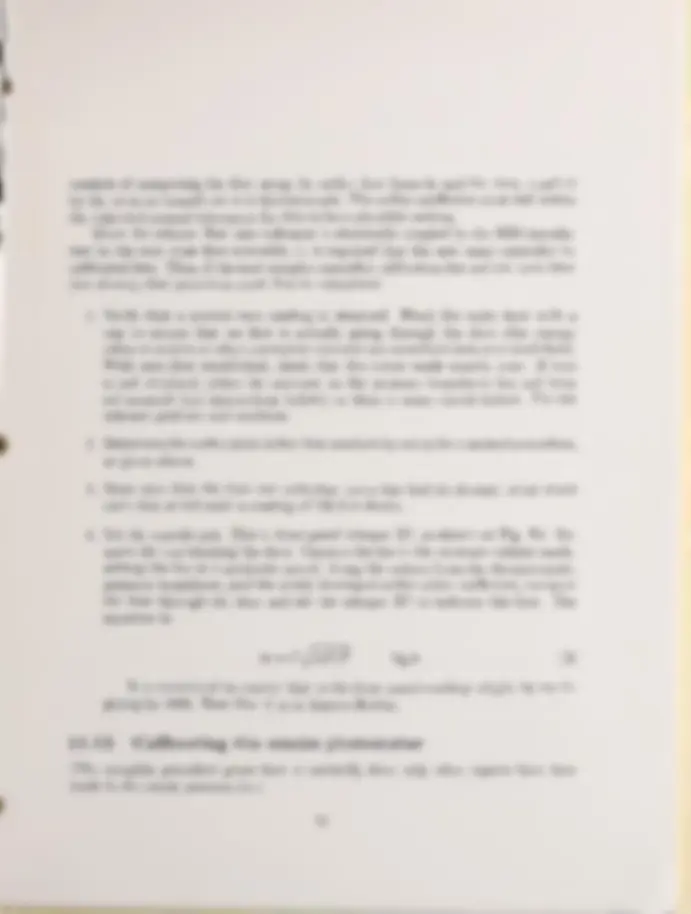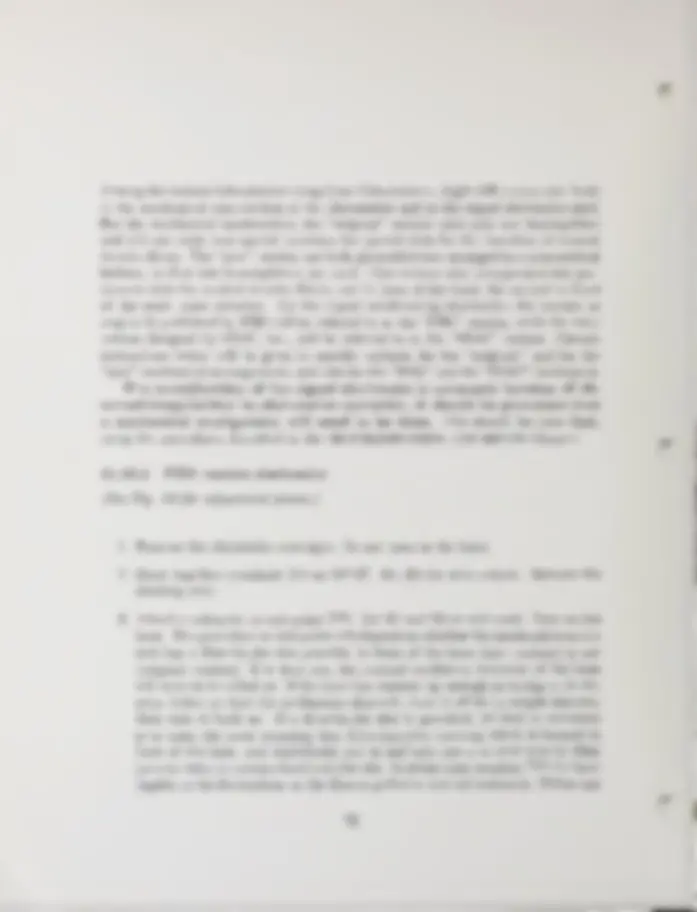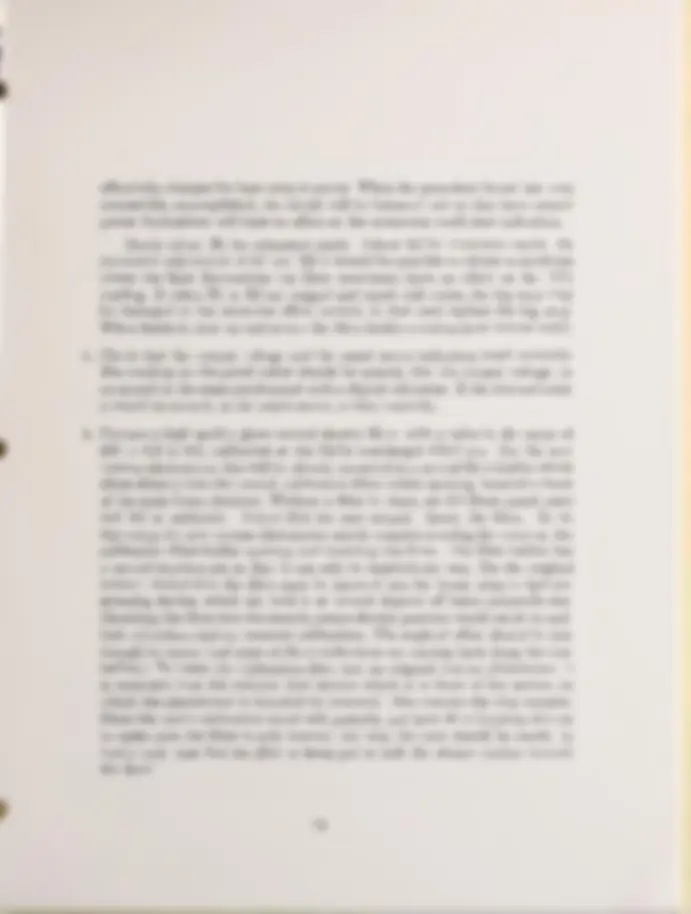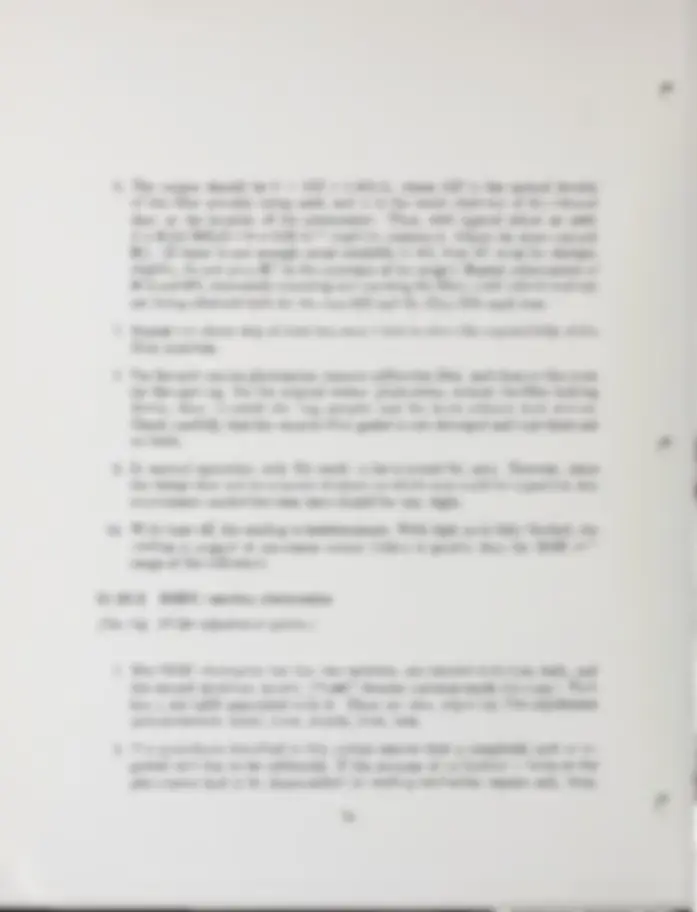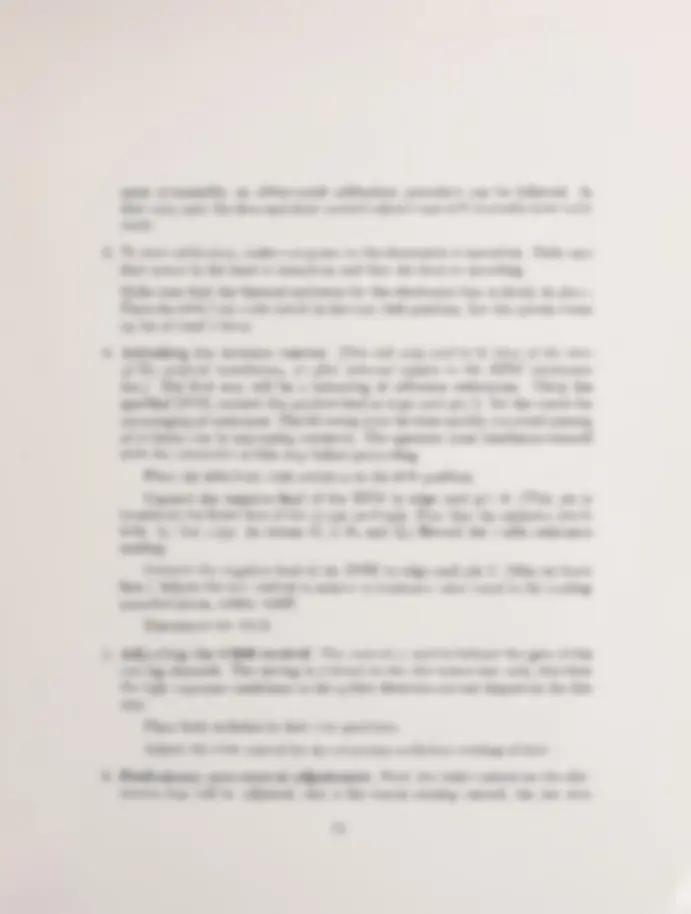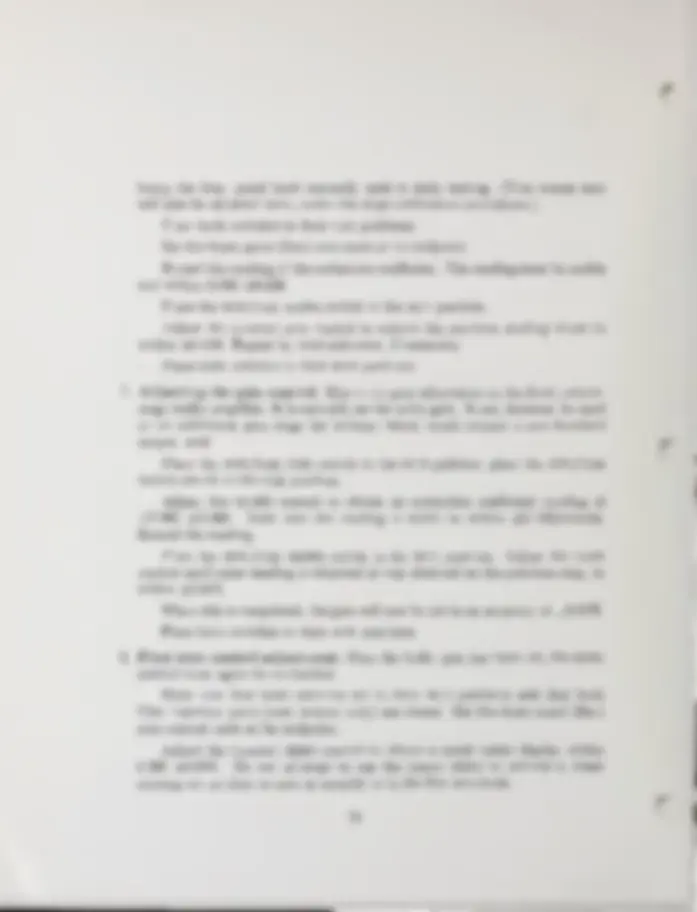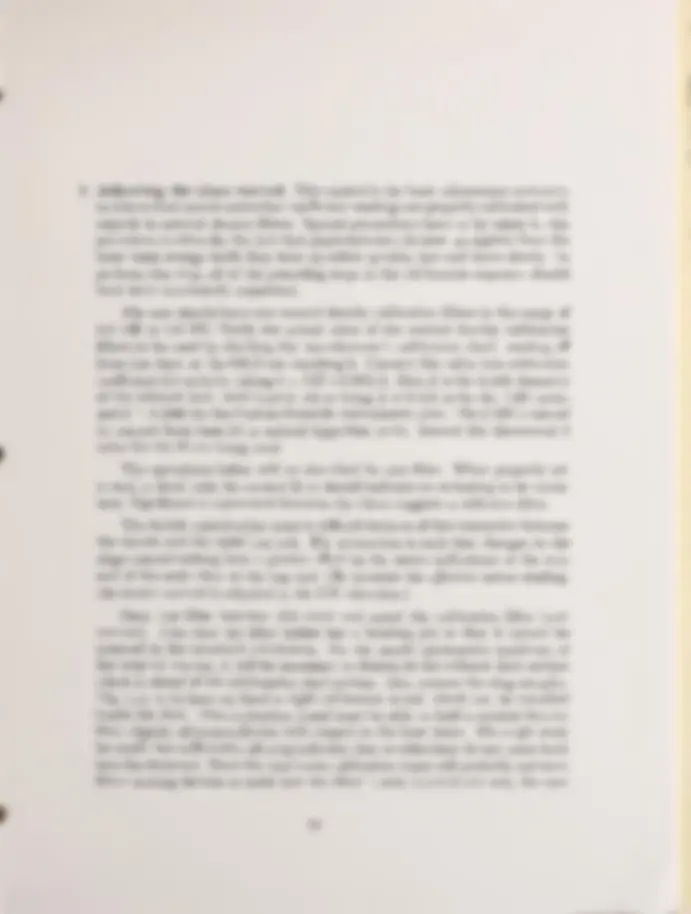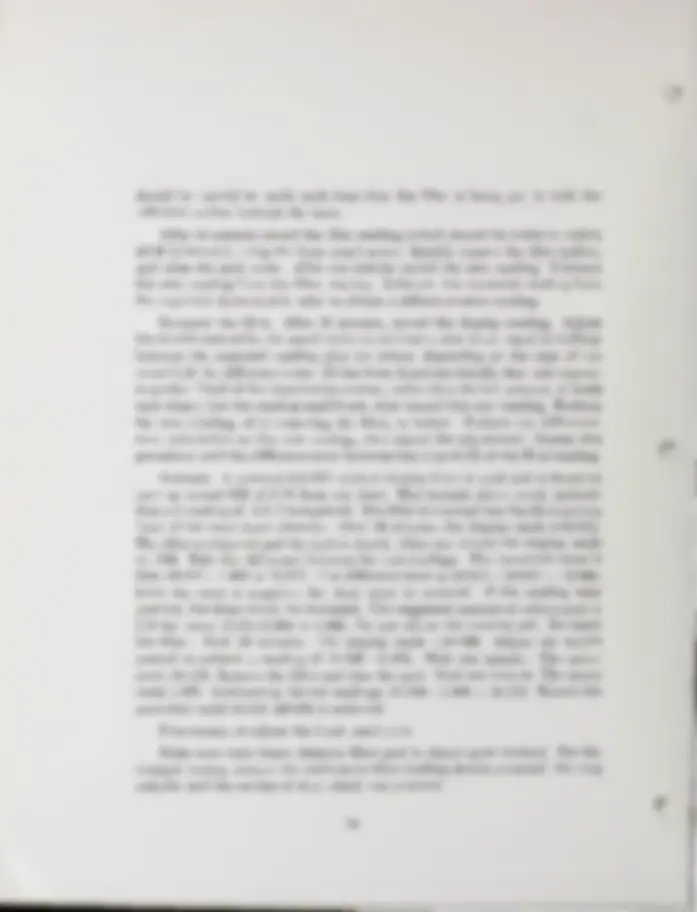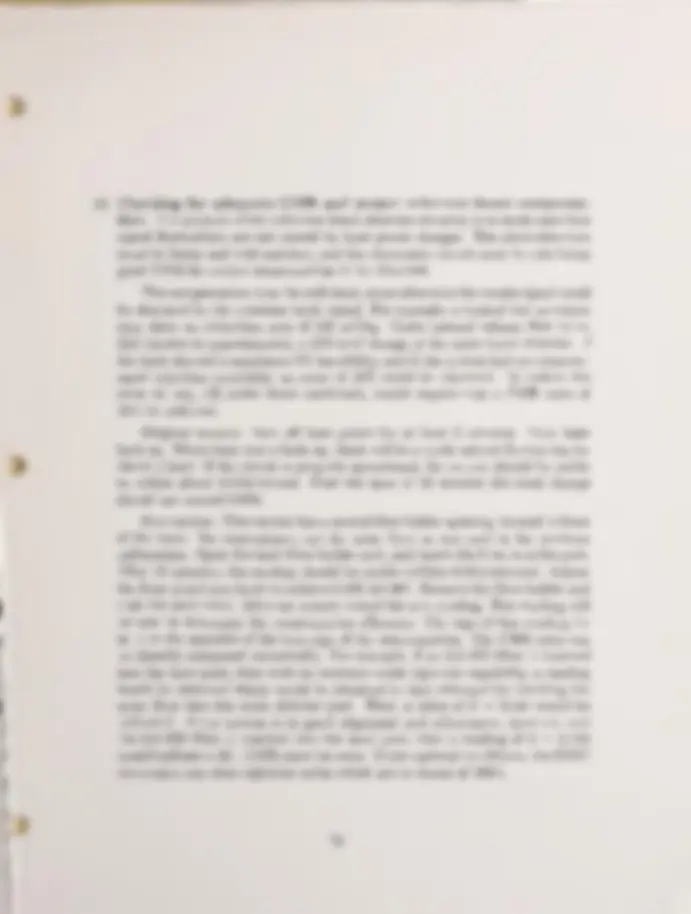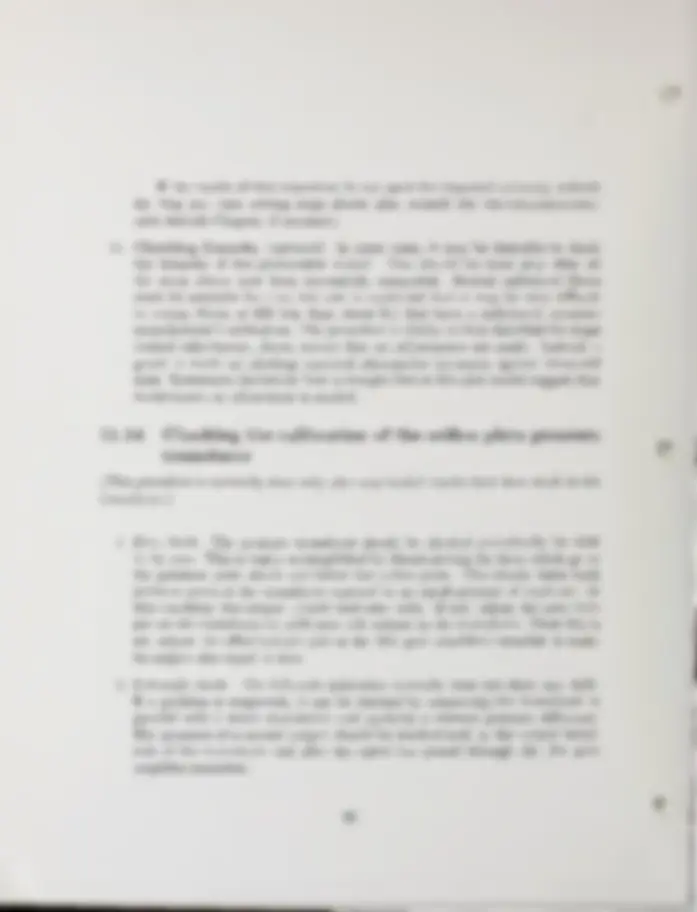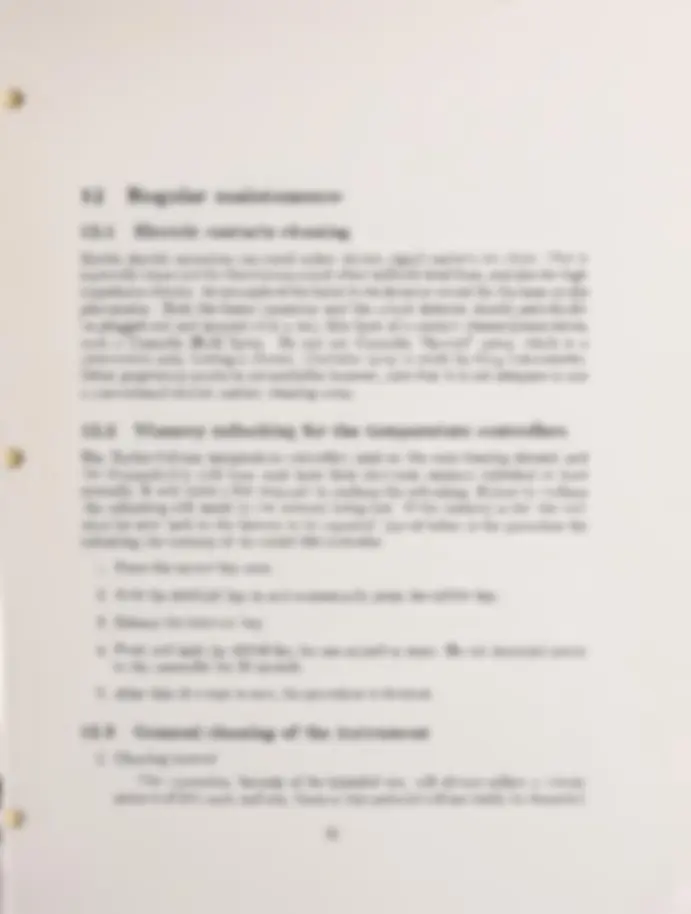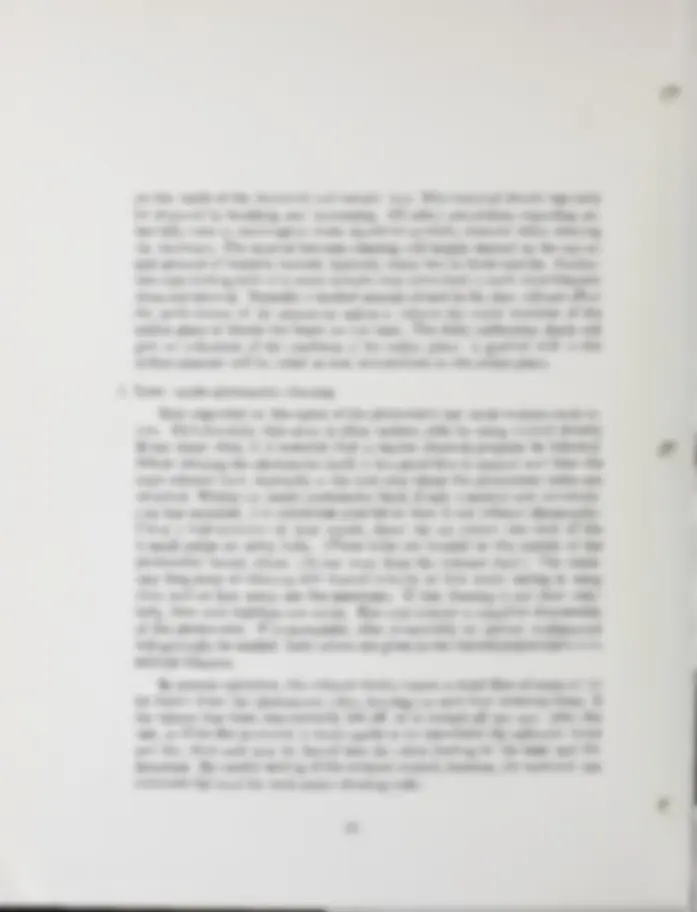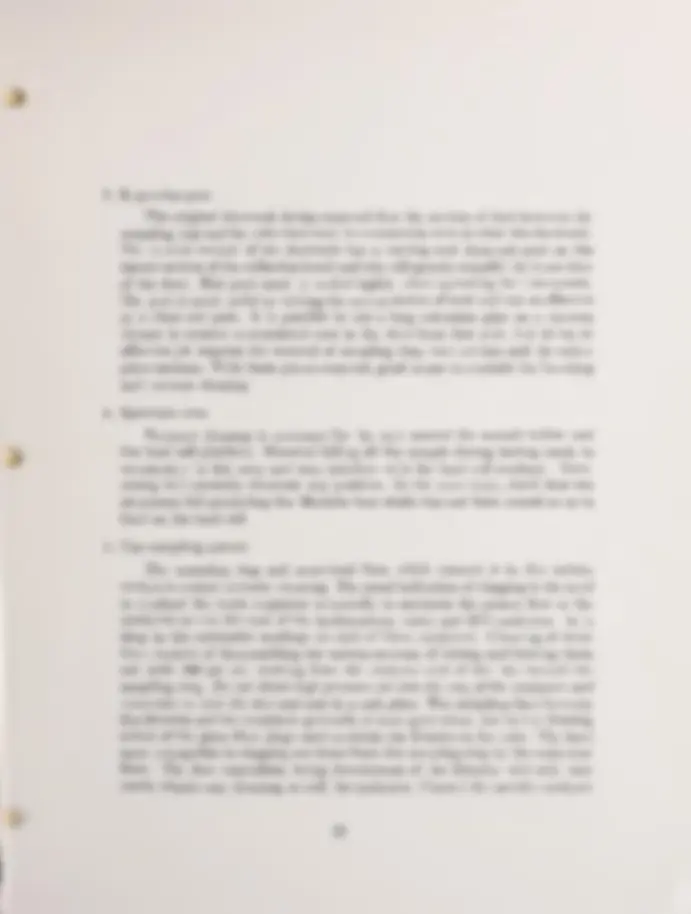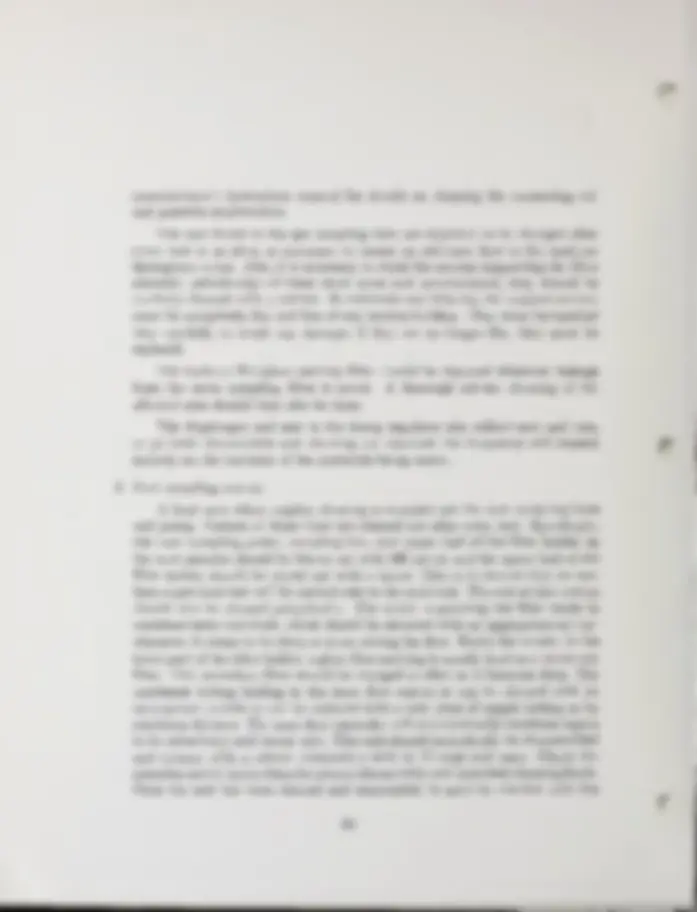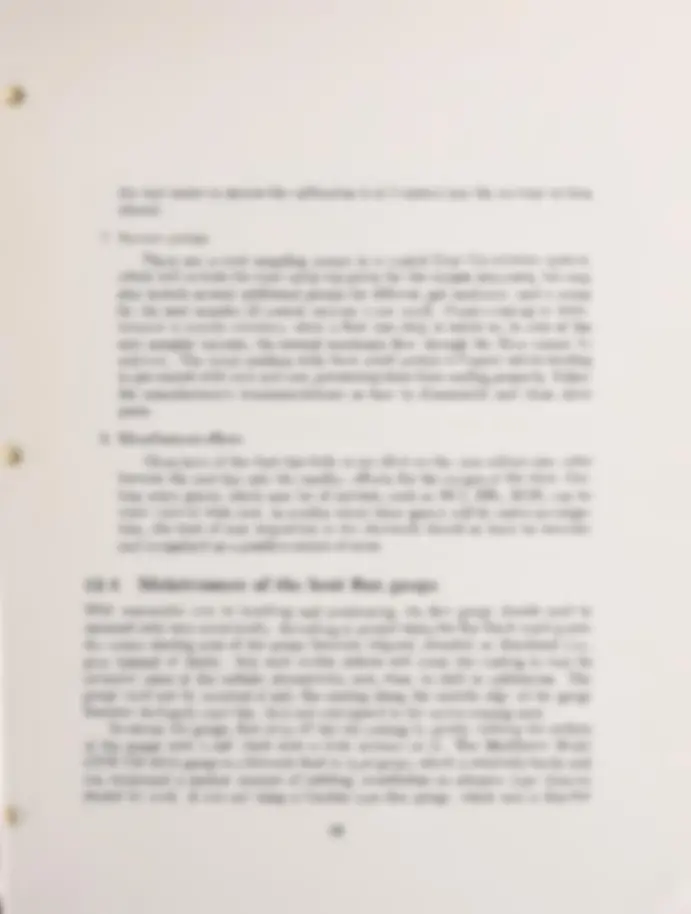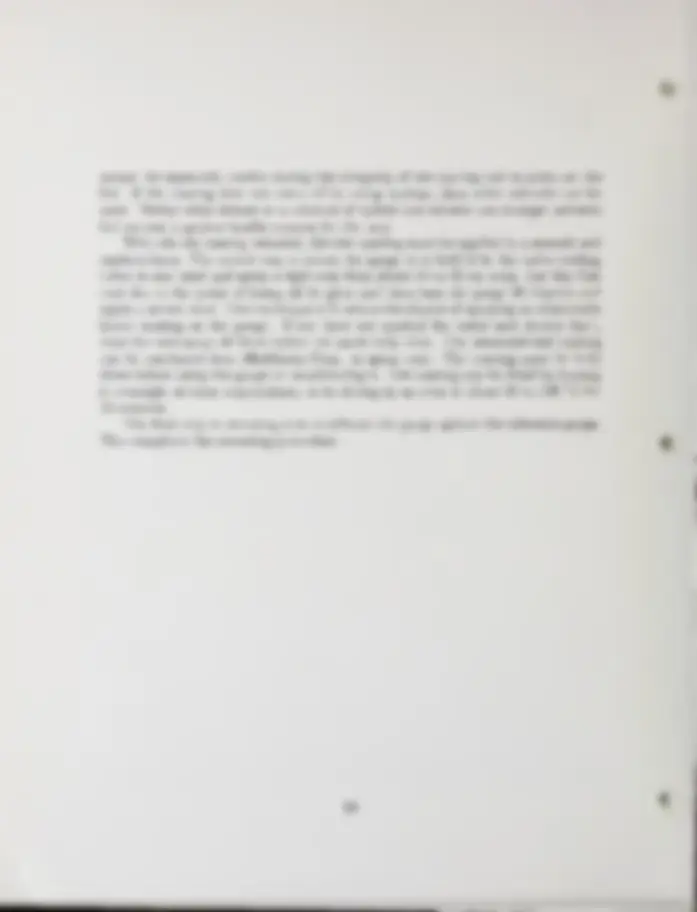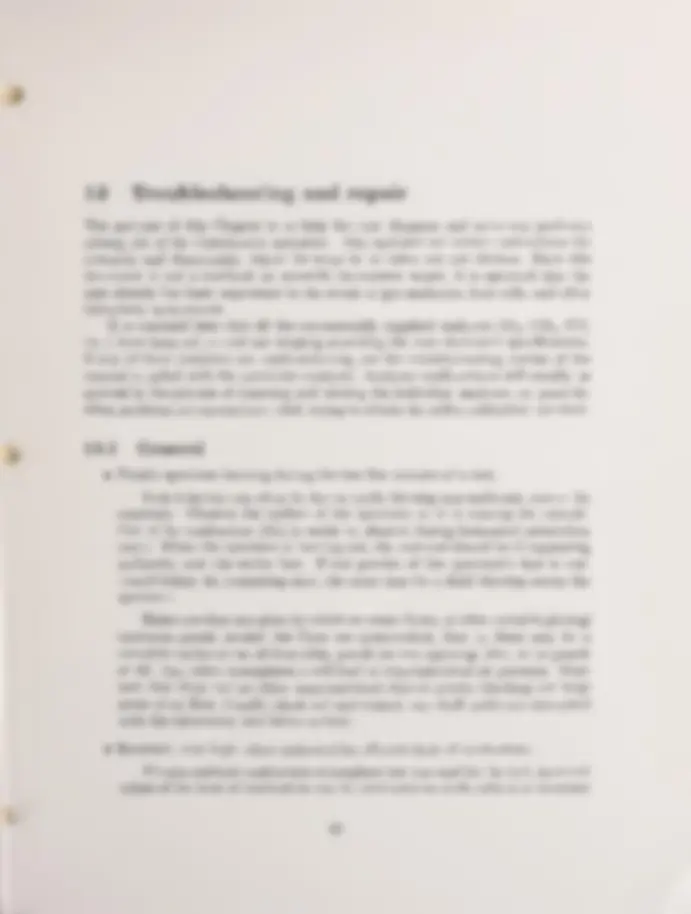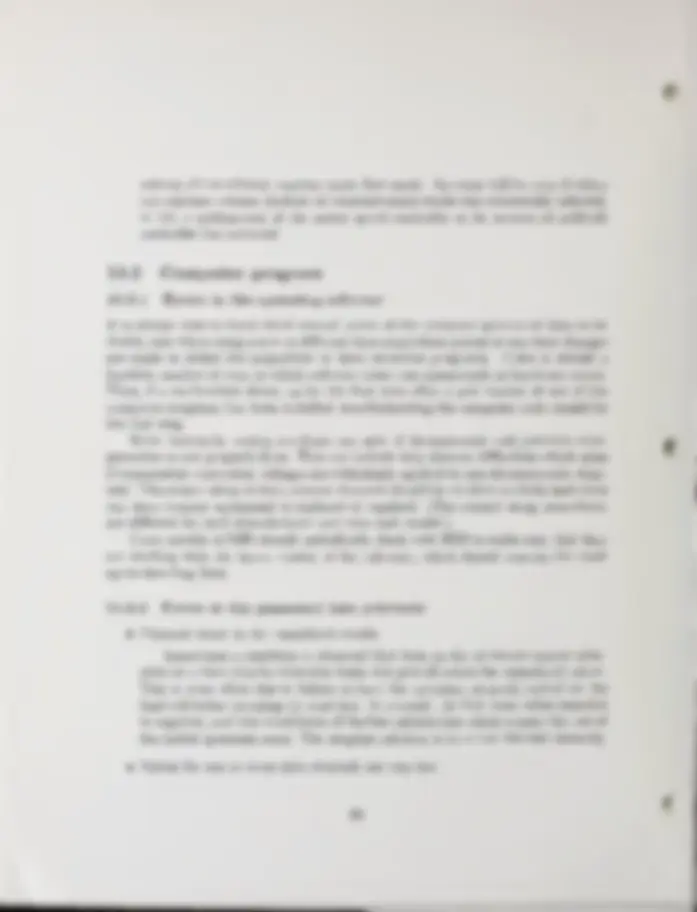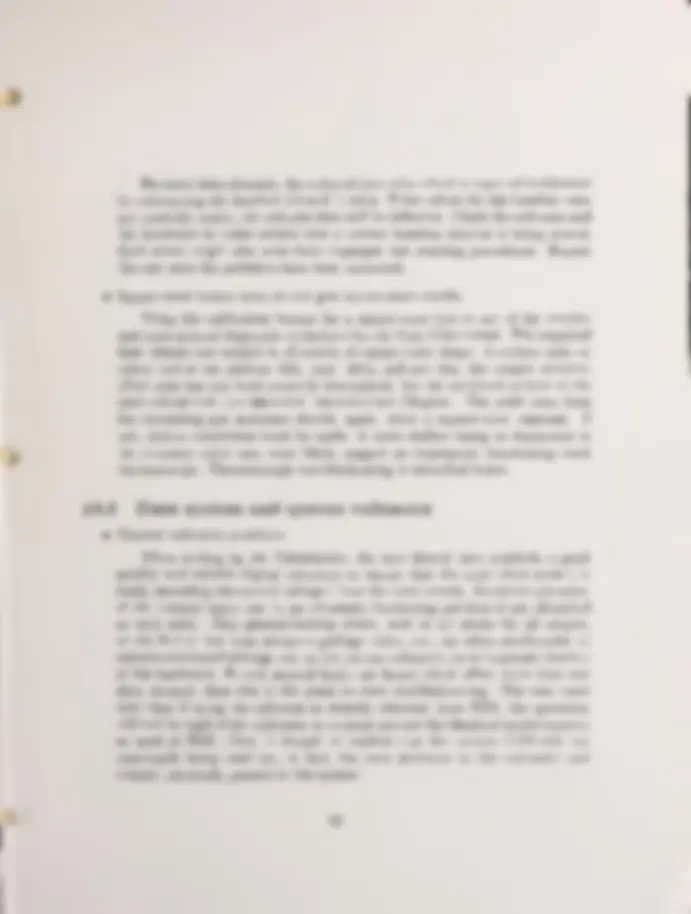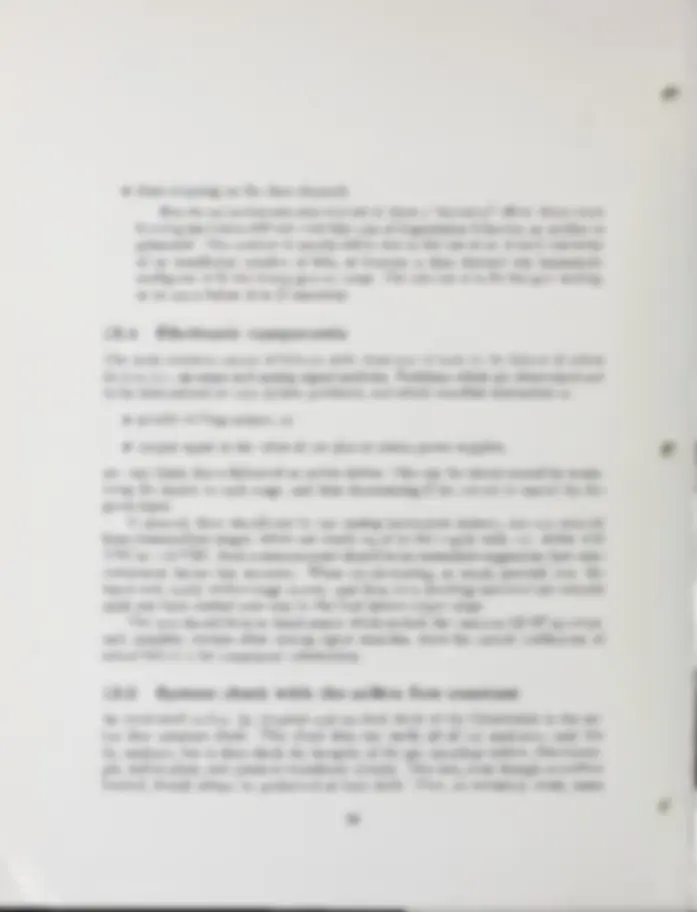Download User's Guide for the Cone Calorimeter: Operation and Maintenance and more Lecture notes Electronics in PDF only on Docsity!
A1 11 02858344
NBS Special Publ ication 7^
User's Guide for the Cone Calorimeter
Uilliam H. Twilley and Vytenis Babrauskas
rhe National^ Bureau^ of^ Standards'^ was^ established^ by^ an^ act^ of^ Congress^ on^ March^ 3,^ 1901.^ The Bureau's overall goal is to strengthen and advance the Nation's science and technology and facilitate (^) their
effective application for public benefit. To this^ end, the^ Bureau^ conducts research to assure international competi-
tiveness and leadership of U.S. industry, science and technology. NBS work involves development and transfer of measurements, standards^ and^ related^ science^ and^ technology,^ in^ support^ of^ continually^ improving^ U.S. productivity, product quality and reliability, innovation and underlying science and engineering. The Bureau's technical work is performed by the National Measurement Laboratory, the National Engineering Laboratory, the Institute for Com- puter Sciences and Technology, and the Institute for^ Materials^ Science^ and Engineering. The National Measurement^ Laboratory Provides the national system of physical and chemical measurement; coordinates the^ system^ with^ measurement^ systems^ of^ other^ nations and furnishes essential services leading to accurate and uniform physical and chemical measurement throughout the Nation's scientific community, industry, and commerce; provides advisory and research services to other Government agencies; conducts physical and chemical research; develops, produces, and distributes Standard Reference Materials; provides calibration services; and manages the National Standard Reference Data System. The Laboratory consists of the following centers:
The National Engineering Laboratory
Provides technology and technical services to the public and private sectors to address national needs and to solve national problems; conducts research in engineering and applied science in^ support^ of^ these efforts; builds and maintains competence in the necessary disciplines required to carry out this research and technical service;^ develops^ engi- neering data and measurement capabilities; provides engineering measure- ment traceability services;^ develops^ test methods^ and^ proposes^ engi- neering standards and code changes; develops and proposes new engineering practices; and^ develops^ and^ improves^ mechanisms^ to transfer results of its research to the ultimate user. The Laboratory consists of the following centers: The Institute for Computer Sciences and Technology
- (^) Basic Standards^
- (^) Radiation Research
- (^) Chemical Physics
- (^) Analytical Chemistry Computing and Applied Mathematics Electronics and Electrical Engineering^ Manufacturing Engineering Building Technology Fire Research Chemical Engineering' Conducts research and provides scientific and technical services to aid Federal agencies in the selection, acquisition, application, and use of computer technology to improve effectiveness and economy in Govern-
ment operations in accordance with Public Law 89-306 (40 U.S.C. 759),
relevant Executive Orders, and other directives; carries out this mission by managing the Federal Information Processing Standards Program, developing Federal ADP standards guidelines, and managing Federal participation in ADP^ voluntary^ standardization^ activities;^ provides^ scien- tific and technological advisory services and assistance to Federal agencies; and provides the technical foundation for computer-related policies of the Federal Government. The Institute consists of the following divisions: The Institute (^) for Materials Science and Engineering Conducts research and provides measurements, data, standards, refer- ence materials, quantitative understanding and other technical informa- tion fundamental to the processing, structure, properties and perfor- mance of materials; addresses the scientific basis for new advanced materials technologies; plans research around^ cross-cutting^ scientific themes such as nondestructive evaluation and phase diagram develop- ment; oversees Bureau-wide technical programs^ in^ nuclear^ reactor radiation research and nondestructive evaluation; and broadly dissem- inates generic technical information resulting from its programs. The Institute consists of the following divisions: Information Systems Engineering Systems and Software Technology Computer Security Systems and Network Architecture Advanced Systems
- (^) Ceramics
- (^) Fracture and Deformation'
- (^) Polymers
- (^) Metallurgy
- (^) Reactor Radiation 'Headquarters and Laboratories at Gaithersburg, MD, unless otherwise^ noted;^ mailing address Gaithersburg, (^) MD 20899. ^Some divisions within the center are located at Boulder, CO 80303. ^ (^) Located at Boulder, CO, with some elements at Gaithersburg, MD.
RESEARCH INFORMATION CENTER
National Institute o-f
Standards and Technology
Gai thersburg I MD 2089?
NBS Special Publication 745 IJser^s Guide (^) for the Cone Calorimeter William H. Twilley and Vytenis Babrauskas Fire Measurement and Research Division Center for Fire Research National Bureau of Standards Gaithersburg, (^) MD 20899 Edition 1. Stimulalinp America's Progress i9ij-i9ee August 1988 U.S. Department of Commerce C. William (^) Verity, Secretary National Bureau of Standards Ernest Ambler, Director
Contents
- 1 Introduction
- 1.1 Customized guides
- 1.2 Sequence of events
- 1.3 User comments
- 2 Installation and initial set-up - 2.1 Laboratoiy environment - 2.2 Services required - 2.3 Calibration and auxiliary equipment required - 2.4 Calibration samples - 2.5 Initial set-up steps - 2.6 Calibration levels
- 3 Spares and supplies
- 4 Data collection and analysis softw^are - 4.1 Data collection - 4.1.1 Calibrate - 4.1.2 Run a test - 4.2 Data reduction
- 5 Daily start-up and calibration procedures
- 5.1 General
- 5.2 Checking the cold trap temperature setting
- 5.3 Changing the drying and CO2 removal media
- 5.4 Draining the condensed water from the cold trap
- 5.5 Changing the soot filters
- 5.6 Activating the hood exhaust system
- 5.7 Gas analyzer calibration (Zero/Span)
- 5.8 Setting the flow rates for the exhaust and for the soot sampler
- 5.9 Checking the orifice flow constant
- 6 Preparative procedures
- 6.1 Sample preparation
- 6.2 Preparing the specimen holder
- 6.3 Use of special sample holder equipment
- 6.4 Preparing weighed soot filters
- 6.5 Recording pre-test data
- 7 Running tests - 7.1 General - 7.2 Checking gas analyzers, sampling lines, filters - 7.3 Checking the cold trap - 7.4 Checking the exhaust duct flow
- 7.5 Setting the soot mass flow controller
- 7.6 Setting the cone heater orientation and height
- 7.7 Checking the load cell
- 7.8 Setting up the desired flux of the cone heater
- 7.9 Computer program setup and starting the test
- 7.10 Ignition
- 7.11 Observing the test
- 7.12 End of test
- 8 Daily shutdow^n procedures
- 9 Test report - 9.1 Computer-generated standard reports
- 10 Weekly calibration procedures - 10.1 Checking the calibration of the electronic mass-flow controller - 10.2 Checking system cahbration with PMMA
- 11 Less-frequent calibration procedures - 11.1 Calibrating the heater thermocouples to actual heat flux values - 11.2 Gas burner checks, 5 and 10 kW level - 11.3 Checking the operating flux gauge against the reference gauge - 11.4 Checking the laser smoke photometer - 11.5 Setting the gas analyzer flow rates - 11.6 Determining the gas analyzer time offsets - 11.7 Setting the oxygen analyzer response time - 11.8 Checking analyzer D-to-A operation - 11.9 Load cell damping factor adjustment - 11.10 Set-up of the controller for the soot sampler
- 11.11 Calibrating the exhaust flow controller
- 11.12 Calibrating the exhaust flow rate indicator
- 11.13 Calibrating the smoke photometer - 11.13.1 NBS version electronics - 11.13.2 SSDC version electronics
- 11.14 Checking the calibration of the orifice plate pressure transducer
- 12 Regular maintenance
- 12.1 Electric contacts cleaning
- 12.2 Memory refreshing for the temperature controllers
- 12.3 General cleaning of the instrument
- 12.4 Maintenance of the heat flux gauge
- 13 Troubleshooting and repair
- 13.1 General
- 13.2 Computer program - 13.2.1 Errors in the operating software - 13.2.2 Errors in the generated data printouts
- 13.3 Data system and system voltmeter
- 13.4 Electronic components
- 13.5 System check with the orifice flow constant
- 13.6 Methane calibration system
- 13.7 Exhaust system blower and indicator - 13.7.1 Mechanical speed check-out - 13.7.2 Checking the zero flow condition - 13.7.3 Flow rate checking with CO2 - 13.7.4 Troubleshooting the exhaust system
- 13.8 General gas analyzer problems
- 13.9 Oxygen measurement system
- 13.10 Thermocouples
- 13.11 Pressure transducer
- 13.12 System checking with additional gas analyzers
- 13.13 Heat flux gauge
- 13.14 Cone heater - 13.14.1 Heater troubleshooting - 13.14.2 Winding a heater element - 13.14.3 Heater replacement
- 13.15 Load cell testing
- 13.16 Laser smoke photometer
- 13.16.1 Alignment of the laser smoke photometer
- 13.16.2 Troubleshooting of the photometer
- 13.17 Soot sampler
- 13.18 Cold trap
- 1 Typical oxygen and flow values List of Tables
- 2 Typical flow rates at specified fan shaft speeds
- 3 Mass yields for reference materials
- 4 Molar relationships for reference materials
1 Introduction In 1982 the National Bureau of Standards (NBS) developed a new type of apparatus for making bench-scale rate of heat release measurements. Rate of heat release was
then beginning to be seen as a key factor in describing the^ flammability^ of^ materials,
products, and assemblies. Laboratory instruments for measuring the rate^ of^ heat release had already been available^ at that^ time^ for over a^ decade.^ These^ earlier^ devices, however, were either of a very simple design and subject to serious measurement errors; or, they were capable of good measurement accuracy, but were of extremely complex and costly construction. During the late 1970's an entirely new principle was discovered for making rate
of heat release measurements. This was termed the "oxygen consumption principle."
The (^) method required very (^) precise means of measuring oxygen concentrations; given such capability, however, it was shown that highly accurate rate of heat release mea- surements could be made without (^) the greatly complex hardware required for earlier designs. A program was then started at NBS to develop a bench-scale rate of heat release test method which could serve as a standard laboratory test. The appara- tus became known as the Cone Calorimeter (due to the conical shape of the heating element). It has been provisionally (^) published by ASTM as P 190. This Guide is intended to provide supplemental information on installation, set-
up, daily operational procedures, and also on maintenance and troubleshooting. It is
assumed that the user has available the following documents:
- (^) Babrauskas, V., Development of the Cone Calorimeter-A Bench-Scale Heat Release Rate Apparatus (^) Based on Oxygen Consumption, Fire and Materials. 8, 81-95^ (1984). Also^ issued^ as^ NBS^ Report^ NBSIR^ 82-2611^ (1982).
- Proposed (^) Test Method for Heat and Visible Smoke Release Rates for Materials and Products using an Oxygen Consumption Calorimeter (E-5 Proposal P (^) 190), Annual Book of ASTM Standards, Vol. (^) 04.07, (^) pp. 1221-1237, American
Society for Testing and Materials, Philadelphia (1986).
- (^) Construction Drav^ings for the Cone Calorimeter. Available from the Center for Fire Research. National Bureau of Standards, Gaithersburg, MD
- The manufacturers' instruction manuals for all the analyzers, controllers, pumps, and other off-the-shelf devices that are incorporated into the Cone Calorimeter. 1
1.2 Sequence (^) of events The sequence of events listed below, in most cases, is not of specific importance. In
those instances where the sequence is important, this fact will be pointed out.
1.3 (^) User comments
Users finding difficulties with these procedures, or encountering anomalous^ conditions
not described in the documentation are urged to contact the National Bureau of Standards. User comments are specifically invited, and will be incorporated into
future editions of this Guide. Phone: (301) 975-6679. Future editions of this Guide
will incorporate additional information and suggestions received from users.
3
2 Installation (^) and initial set-up 2.1 Laboratory environment The apparatus has been designed to operate satisfactorily only in a draft-free environ- ment. While adequate ventilation must be ensured, as described below, it is essential
that there be no serious cross-drafts blowing through the test area. Such drafts will
create combustion complications and non-uniformities.
2.2 (^) Services required
- Ventilation. A hood system is required which can (a) remove the maximum
of 50 tjs from the exhaust stack, while being decoupled from it [that is, the
Calorimeter exhaust stack should empty into a collection hood, rather than being directly plumbed into the building exhaust]; (b) remove any smoke drifting up due to specimen insertion or removal; and (c) allow burned specimens to be temporarily placed in a (^) safe location. (^) The requirement for a decoupled
configuration is to avoid introducing pressure fluctuations from the building
ventilation system or from the outside weather. In practice, thus, the actual
rated capacity will have to be, possibly, ten times the maximum 50 ^|s coming
from the exhaust itself.
- Electrical power. Electrical power providing (^240) VAC at the instrument must be available. If only a lower voltage, e.g.^ 208 VAC, is available, a boost trans- former will be required. If nominal (^240) VAC mains are available, but actual delivered voltage is less, the user should expect to find that the rated 100 kW/m-^ irradiance capability may not be achieved. Thus, a boost transformer will be necessary in such cases also. The minimum current capacity required is at least 25 A for the heater, plus the total rating for the remaining devices and
instruments. This, in general, will depend on the installation, although, for
commercial instruments, the manufacturer should be able to provide a value.
- Water supply. Water supply is necessary to cool the heat flux gauge and cold trap. This is a very minimal flow; a pressure regulator set at 250 kPa (^) (35 psi) should be provided (^) if house pressure may undergo surges greater than this value.
- Drain. A drain line is required to handle the water being provided. 4
- Laboratory weights. A set of laboratory weights is (^) required for checking (^) the cahbration of (^) the load cell.
- Specimen holder equipment. In addition to two each (^) (minimum) of (^) the horizon- tal and vertical orientation (^) specimen holders, the user may need the following items:
- An edge frame, used for testing in the horizontal orientation, of wood
products and other specimens whose edges need special protection against
edge burning.
- A wire grid, used either inside the vertical specimen holder, or else in
conjunction with the horizontal edge frame, which functions to restrain
intumescing materials.
- A fabric specimen tensioning insert, (^) used for testing fabric specimens over
a dead air space; used in conjunction with the edge frame above.
Descriptions of all these items are given in the Construction Drawings.
- Special tools for aligning and calibrating laser smoke photometer. For align- ment, two main tools are desirable, as shown in Figure T2. The first is a metal rod, somewhat smaller than the I.D. of the beam tubes that are welded onto the sides of the exhaust duct. The second is a translucent plastic plug with a thin
area in the center, used for inserting in place of a photodetector assembly (or at
the end of the main photometer tube, farthest away from the laser). This plug
is used as a target for aligning the laser beam. For calibration, the procedures
will differ, depending on whether the photometer hardware is of the "original"
or of the "new" design (details are given in the LESS-FREQUENT CALIBRATION PROCEDURES (^) Chapter). For units of the original design, the user has to con- struct a filter-positioning device, which can be inserted into the beam inside the
exhaust duct, once the front half of the exhaust duct is removed.^ This^ device
must be able to position a filter nearly, but not quite perpendicularly to the laser beam. Two (^) glass neutral density filters are required, typically at values of approximately 0.3 and 0.8 optical density ("OD") units, calibrated^ at^ the laser wavelength of 623.8 nm. For units of the new design, filter positioning
provisions are already incorporated into the photometer, thus, the user^ needs
only to have a calibration filter already mounted in a filter holder^ which^ mates
with the special filter slots.
6
- Vacuum cleaner. A shop vacuum cleaner is normally required to clean up the
debris of specimen burning.
2.4 Calibration samples The user should procure and regularly use the normal calibration sample for the Cone Calorimeter. This sample is PMMA (polymethylmethacrylate) cast sheet stock. It can be obtained as Polycast^ black, 25 mm thick^. [The prior manufacturer for these specimens had been Rohm & Haas. They are no longer producing^ this^ plastic^ in^ the required thickness, and, therefore, Polycast is now specified as the supplier. The new data obtained from (^) Polycast will not (^) be identical (^) to any old measurements obtained from Rohm &: Haas stock.] These samples are not prepared in the standard way, as described in ASTM P (^) 190, but rather are to be prepared in the following special way: Cut the specimens to be 100 mm by 100 mm in area. Obtain cardboard stock, approximately (^) 0.5 mm thick. Prepare from (^) the cardboard strips (^25) mm wide by 100 mm long. Use a thin layer of adhesive to attach the strips to each edge of the specimens. Cure for at least 24 hours. The adhesive used must hold the cardboard strips firmly during the burning process. Note that no aluminum foil is used with these specimens, and that the protective paper sheets (^) on the top and bottom faces of the plastic must be removed prior to testing. The purpose of the cardboard strips is to
create a slow-burning condition at the edges. This allows the specimen
regression rate at the edges to approximate that at the center.
The user should retain test data from previous PMMA calibration runs, and compare against those, when necessary in the process of troubleshooting. The flux values are normally chosen to (^) be (^) 25, 50, 75 kW/m^. Note that since these calibration runs are for the purpose of diagnostic testing within one laboratory only, ASTM P 190 does not standardize this procedure. ^Certain commercial (^) products and materials are identified in this document in order to adequately specify the experimental (^) procedure. In no case does such identification imply recommendation or endorsement by the National (^) Bureau of Standards, nor does it imply that the product or material identified is the best available for the purpose. ^Type Cellcast BK2025, from Polycast Co., 69 Southfield Avenue, Stamford, CT 06902. Tele- phone: (^) (800) 243-9002. 7
Oxygen analyzer 0 to 2.5 V Load cell 0 to 1.0 V Stack thermocouple 0 to 50 mV Pressure transducer 0 to 2.5 V Laser smoke photometer 0 to 5.0 V Photometer thermocouple 0 to 50 mV Soot mass flow indicator 0 to 2.0 V
- Set up and test out the computer programs to be used^ for^ data^ collection^ and reduction. With the program running, check that cold-junction^ compensation^ is
being properly done for all thermocouple channels. Cold-junction compensation
(and linearization) can be done by hardware, by software, or by a combination
of both. Since the actual scanner equipment used can not only vary from
laboratory to laboratory, but may also be changed to a different type within one laboratory, specific set-up steps cannot be given for general advice. The operator must make certain, however, once the hookup has been made and the
data collection and reduction programs to be used have been installed on the
computer, (^) that the proper operation is checked out. (^) To do this, prepare the computer software to output the necessary temperature channels (there will be at least two—the stack (^) thermocouple and the smoke photometer thermocouple). Make sure the instrument has not been heated and all temperatures are at ambient. Measure the laboratory air temperature with a thermometer. Then scan the temperature (^) channels on the data system and record their readings in degrees (^) C. A reading close to that obtained from the room thermometer should
be found. If not, adjust appropriate hardware switches on the data system,
or correct the computer program routines. It may also be desirable to make a
similar check at an elevated temperature, for which a boiling water bath can be
used.
- Put in all (^) soot filters and turn on the sampling pumps to all analyzers, even if their outputs are not to be used, so room air will not be drawn backwards through (^) one of the other analyzers and pumps and appear as a leak in the
sampling line.
- Roughly check the zero and span on each gas analyzer. Check that the load cell responds to weights. If any instruments are seen to be faulty, repair them before (^) proceeding. 9
- Perform all the steps indicated in the LESS-FREQUENT CALIBRATION PROCE- DURES Chapter, below. Steps which had been performed by the instrument manufacturer may not need to be repeated at this time.
- Perform all the steps indicated (^) in the WEEKLY (^) CALIBRATION PROCEDURES
Chapter, below.
- Perform all the steps indicated in the START-UP AND DAILY CALIBRATION PROCEDURES Chapter, below. An orifice flow constant in the range 0.040 to
0.046 will be obtained for a unit which is constructed exactly according to the
NBS drawings. For units with different duct dimensions, different blowers, etc., a different orifice flow constant will be expected. Once it has been verified
that all systems are fully correctly operational and that no leaks are present
anywhere in the gas sampling system, the operator should record the constant
obtained. Future calibrations which do not produce this constant, to within
about ±0.003, will indicate a need for troubleshooting and repair.
- Once all is in good operation, it is desirable to procure some calibration PMMA material, burn it, and compare results to expected values (details are given in the WEEKLY CALIBRATION PROCEDURES Chapter). Once this is successful, it can be assumed that the installation is satisfactory. 2.6 Calibration (^) levels The standard calibration procedures, described in the START-UP AND DAILY CALI- BRATION (^) PROCEDURES Chapter, call for calibration at a 10 kW level. This level has been chosen because it represents a high heat output, but is not the maximum output detectable. Values (^) up to (^) approximately 20 kW can be recorded. The 10 kW calibration level is chosen to avoid overheating the equipment. At this level, indefinite operation can take place, therefore, calibrations may be made^ in a deliberate and methodical manner. Extensive operation at the 20 kW level may result in some ductwork warpage. Heat release rate peaks in excess of 10 kW^ are^ rare;
it is expected that they are accurately measured, however, since linearity studies have
shown excellent linearity in the 0 to 12 kW region. 10

